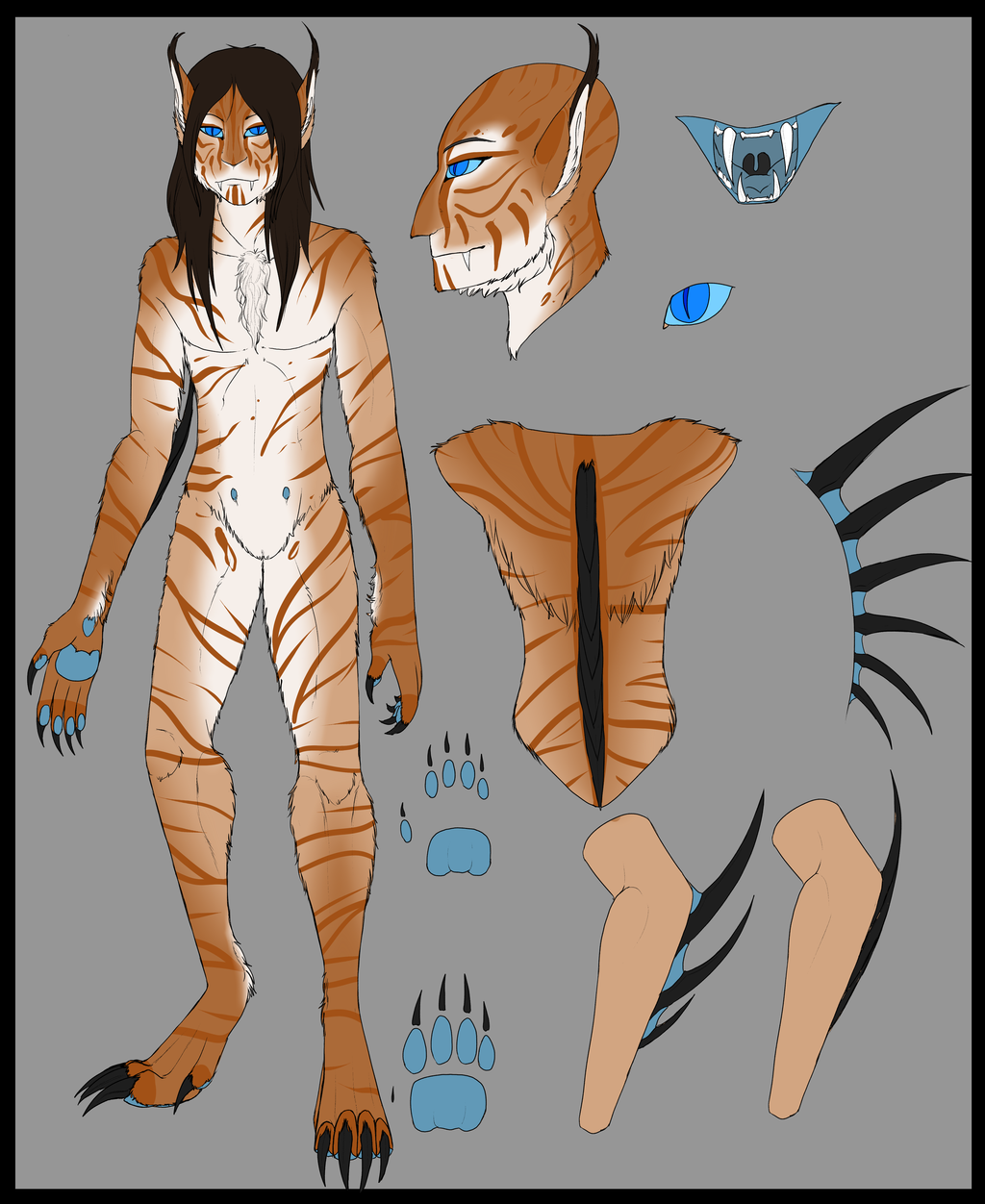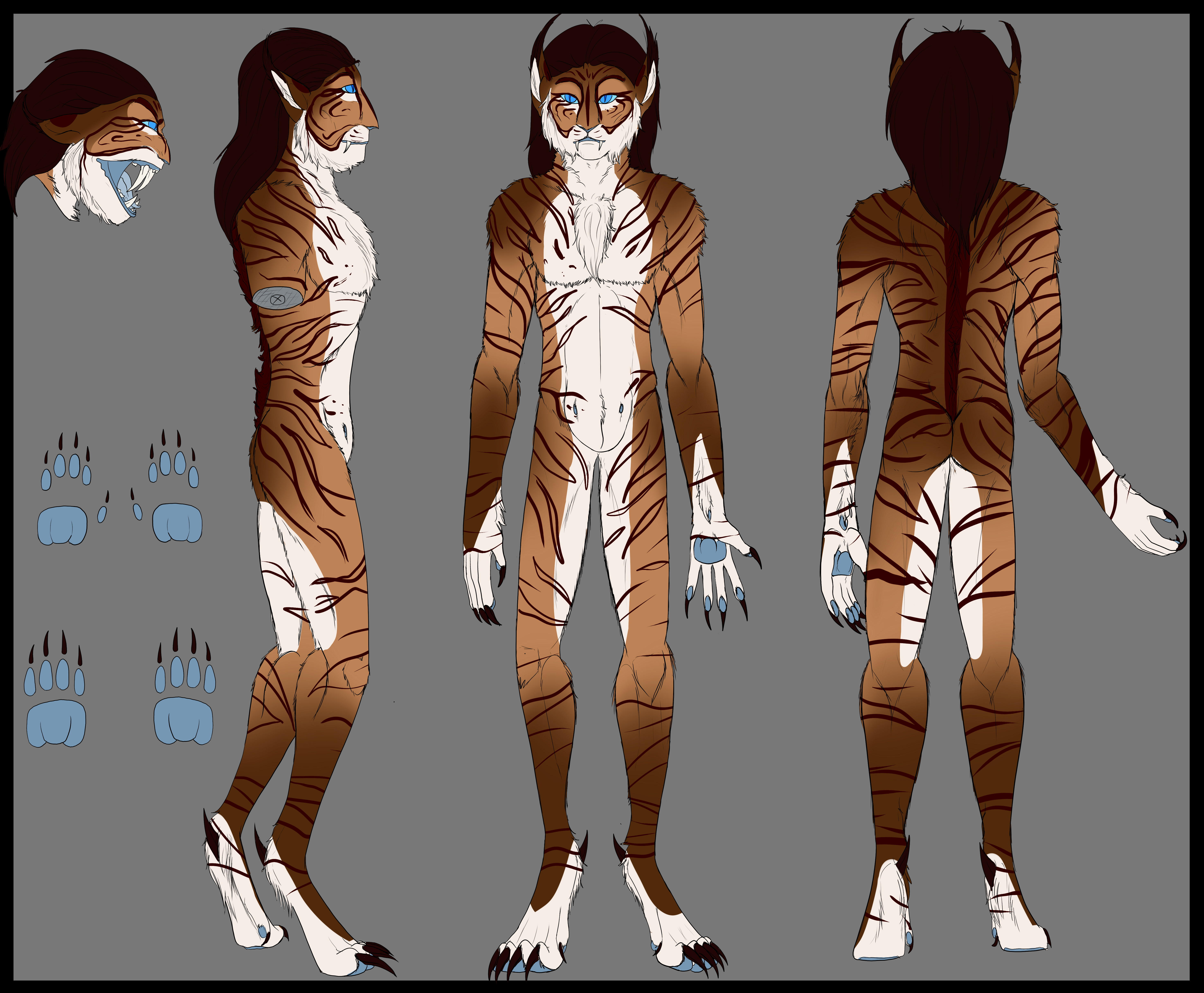Subtypes
Common (Li'uhn Subtype)
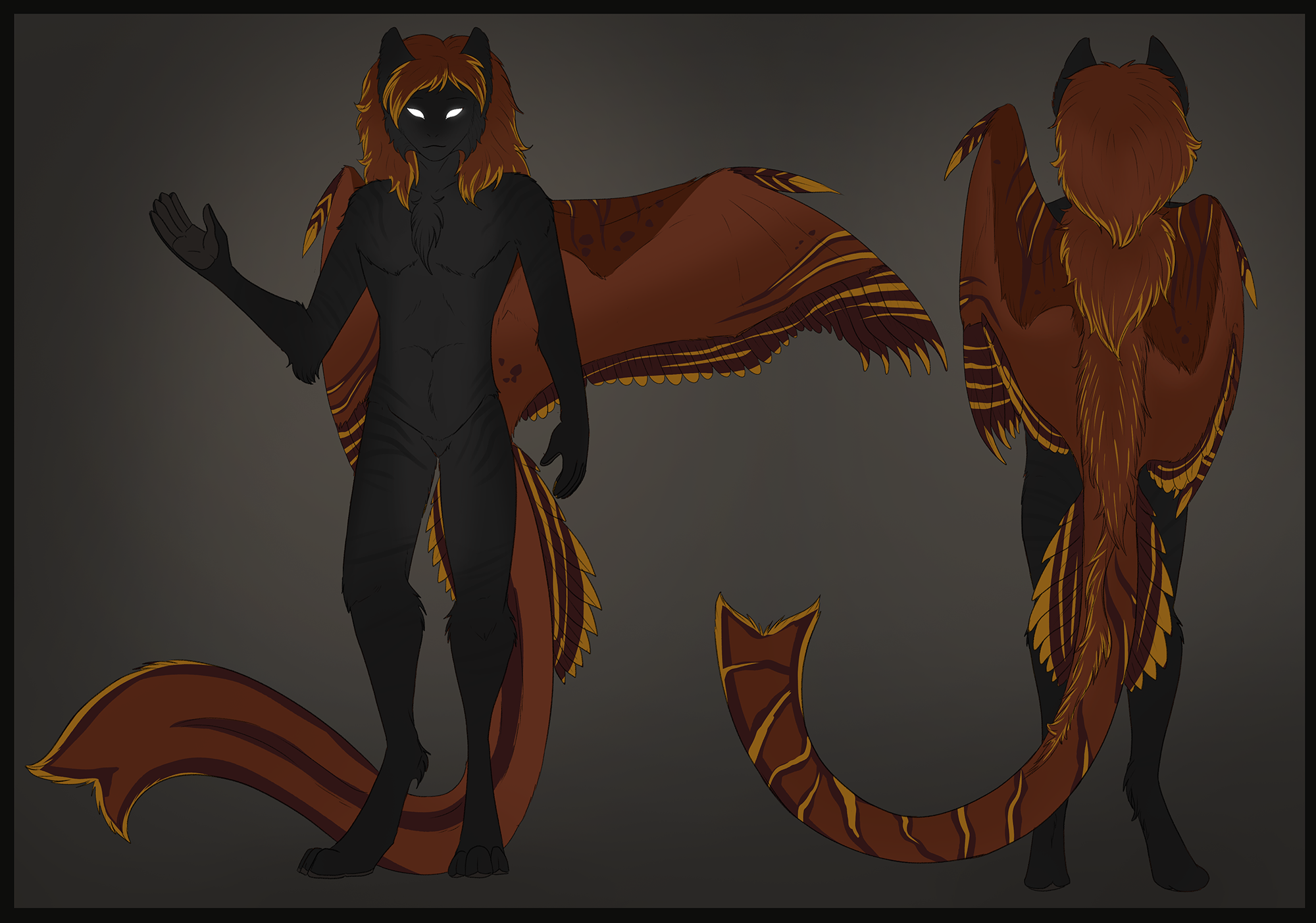
The most common variant of the Li'uhn. They are generally black with red hair, wings and tails. The average member of the species, which is the bulk of them. Li'uhn thrive, and the red ones are everywhere! Their skin can range from black to various shades of brown. It’s always dark. The hair is always gold tipped, and the wings are always in shades of red. They can fly fairly well using energy stored in their tail, and are excellent gliders. They average about five feet tall.
Common Skin Color - Black, Various shades of Dark Brown
Common Markings - Striping, spotting, banding
Darkening on the face, limbs, and ears, in siamese 'point' markings. These can form a darkening down the back and extend to the shoulders and hips.
Subtle lightening to the belly and chest area
Freckles or Flecks on the cheeks, and can be lighter or darker than the skin beneath. Freckling is darker than skin tone on dark brown Li'uhn, and often extends onto the shoulders and hips
Wings are the most free as far as markings go. They are usually lighter on the underside towards the bottom, with darker feathers. Striping of a darker color is common on the feathers and along the topside of the wing, with golden tips to feathers as well as gold stripes along the feathers. Gold marks often follow any striping on the wing. The tail is usually striped, though can have clouded-leopard like markings along its length. The example Lhuin all show what their wing markings look like.
Woolie (Li'uhn Subtype)
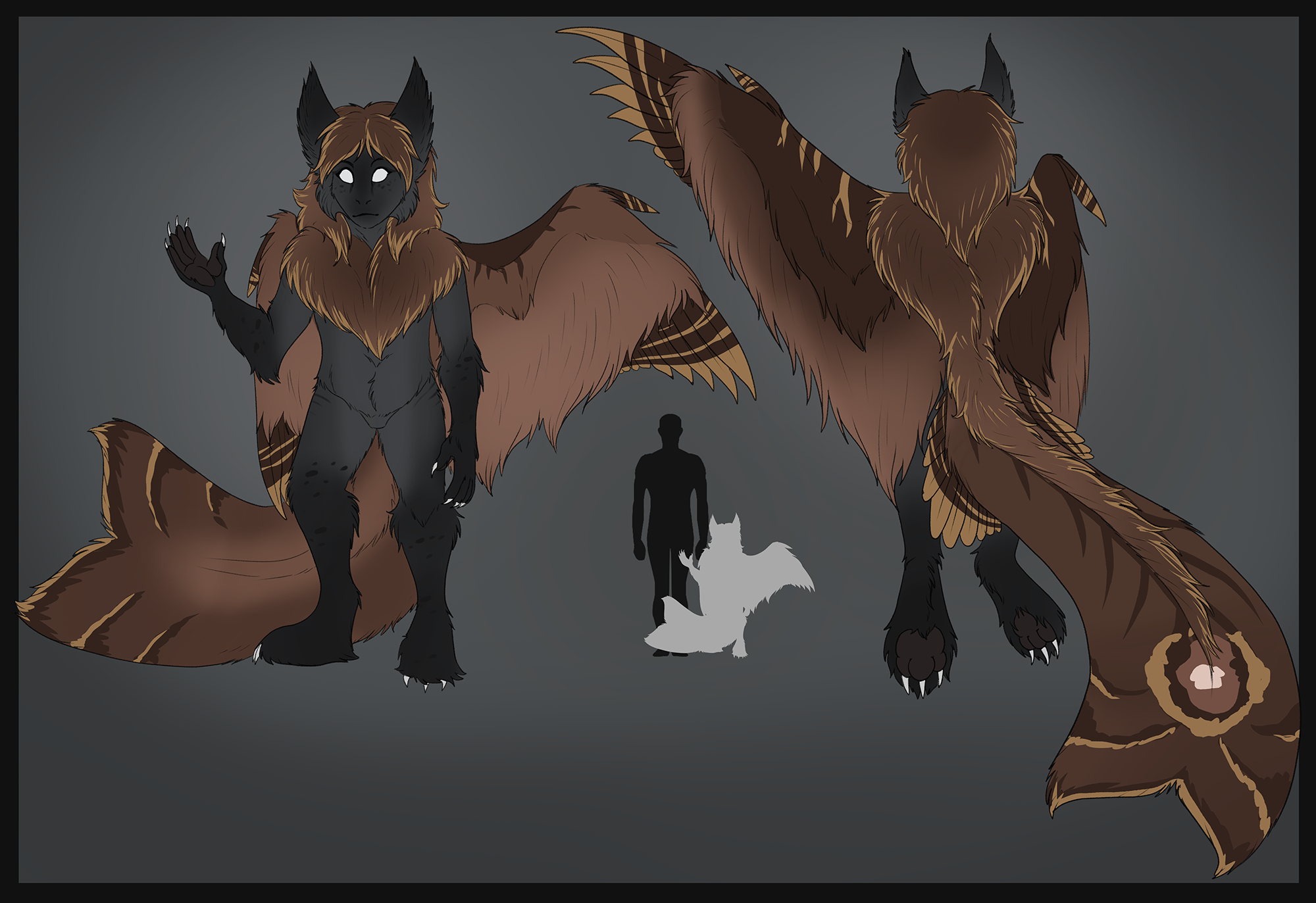
These small, fluffy Li'uhn were initially created as pets for Il’hune. They have two variations, they generally appear in faded, less saturated reds than the common Li'uhn. Even as adults, they are small enough to fit into an adult Il’hune’s pouch, which the Il’hune thought to be the most adorable thing. They were created with the sole intention of being as absolutely adorable as possible, thus the naturally pudgy appearance, big round eyes, tiny peeping voices, massive amounts of soft fluff, and small size, the size of an Il’hune baby when they first start to come out of the pouch. Even the way they flutter and can’t fly well was designed to be as endearing as possible, as they flutter and fly awkwardly much like a baby Il’hune learning to fly. They were popular as pets and companions, though have the same intelligence as any other Li'uhn. Most just let it happen and rather enjoyed the pampering, as Li'uhn are fairly calm and docile by nature. Woolies, as they have been affectionately named, are far more tolerant to cold than regular Li'uhn, and can survive even in the ice and snow in the mountains. They tend to travel in groups, and sleep in big huddles of snuggly cuteness. They love packing themselves into small spaces.
An adult Woolie is around 3 feet tall.
Woolies always have the Woolie mane
Lynx frill fur is free on this subtype. They can have a single large rosette on their tail, though any more need the Leopard marking
Flutterwing (Li'uhn Subtype)
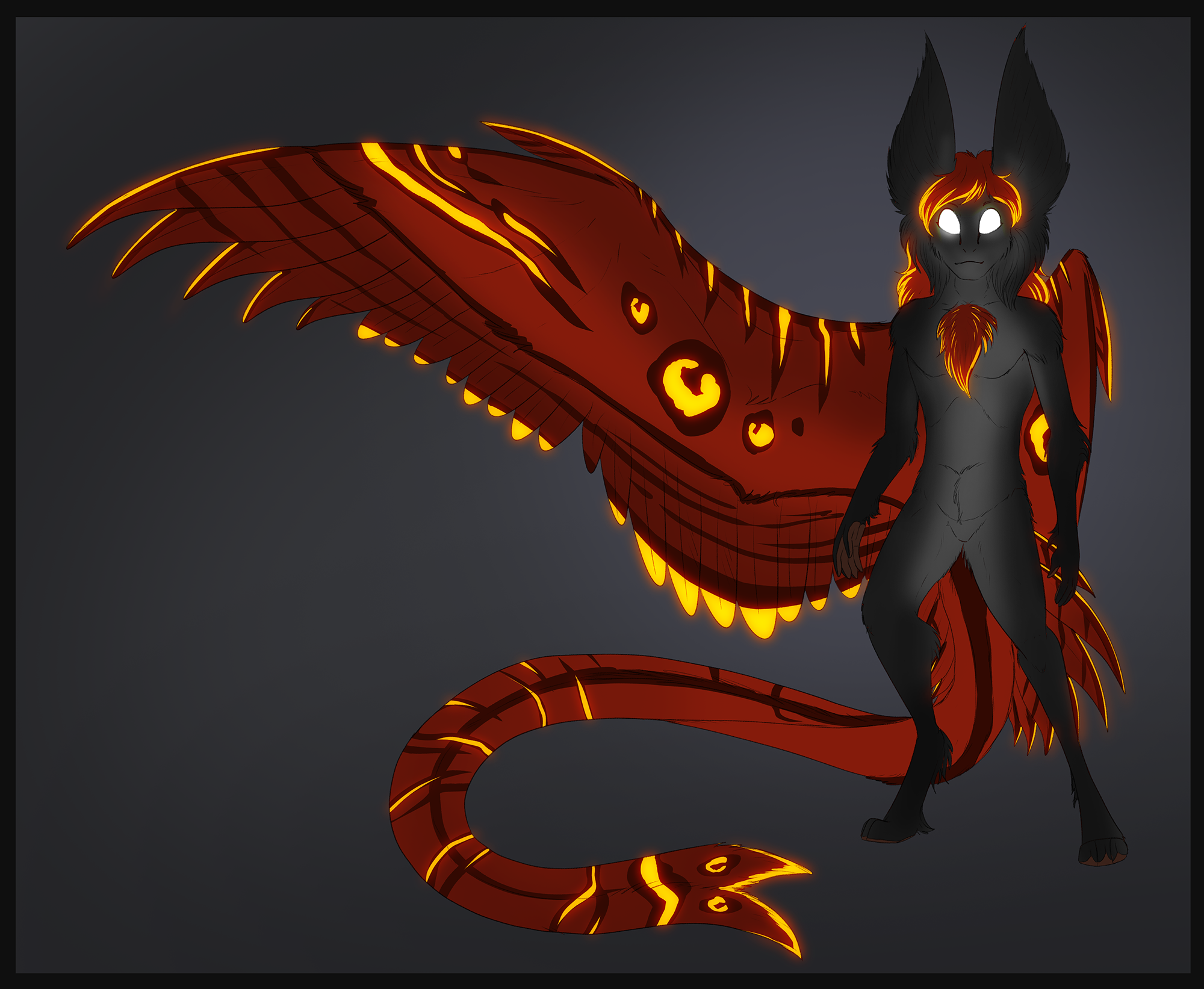
The Flutterwing was commonly used as scouts and pets before the il'hune went extinct. They are quite common and can be seen just about anywhere other li'uhn are. They are a common subtype, though cost 1 Upgrade Token to upgrade to from a common build.
They tend to gather in groups.
-Flutterwings can have a thraoted marking, which makes their throat and chest vibrant, like a robin. This is free for Flutterwings, but inherited for others. (Though they can also have a fluffy chest puff instead or in addition to it)
-Flutterwings can have the Eyespots marking by default, appearing on their wings and two on the end of their tail.
-Flutterwings have the Fennec frill, which is quite large and perked up. Similar in shape to the Anubian frill, but longer.
-Have the Ribbon tail by default, making the tail noticeably longer than it would be otherwise
They glow naturally, whether or not they are using their magical energy.
Flutterwings are able to fly fully on the power of their own wings without needing to boost with magic. They have incredible stamina, and can fly for hours and hours without stopping to rest.
They tend to be very skittish.
Silverwing (Li'uhn Subtype)
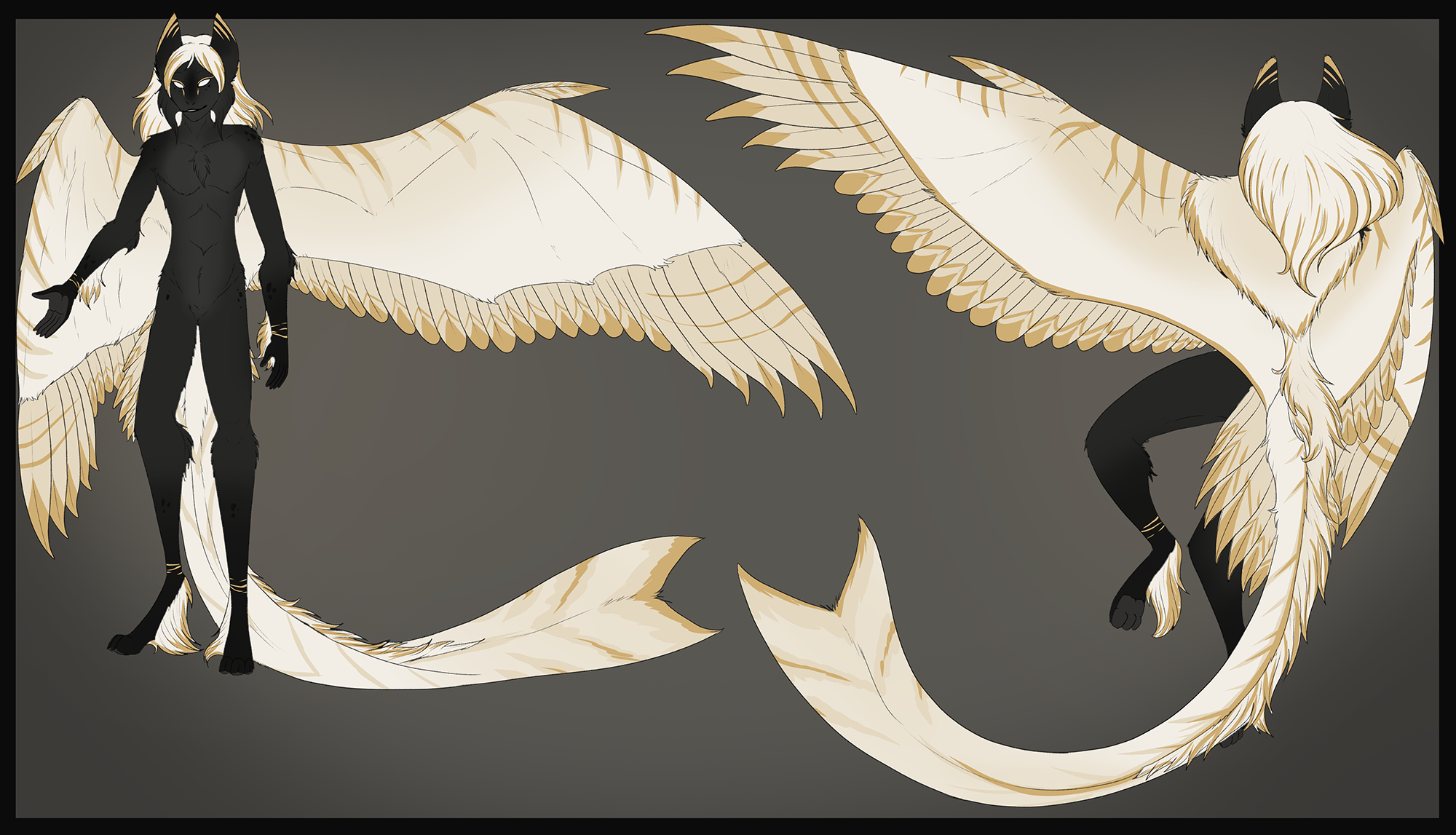
Elegant and beautiful, the Silverwing is a trait inserted into the Li'uhn purely for looks and beauty. They were often the pampered pets/companions of high-status Il’hune before they wiped themselves out. The tallest of the Li'uhn, they also have the largest wings and are powerful fliers. Silverwings often have small troops of common Li'uhn following them around, because they create a nice backwind when they fly, allowing the others to use their backwind to glide along with them. This often ends up in a little pyramid formation with the Silverwing at the forefront, happy to help their smaller fellows. While beautiful and able to fly very well, Silverwings are not considered any more important than any other Li'uhn, as they all view eachother as equals.
The tallest of the Li'uhn, they average around six feet and five inches tall.
Feathering and Extended Markings are both free to add to a Silverwing.
Stoneclaw (Li'uhn Subtype)
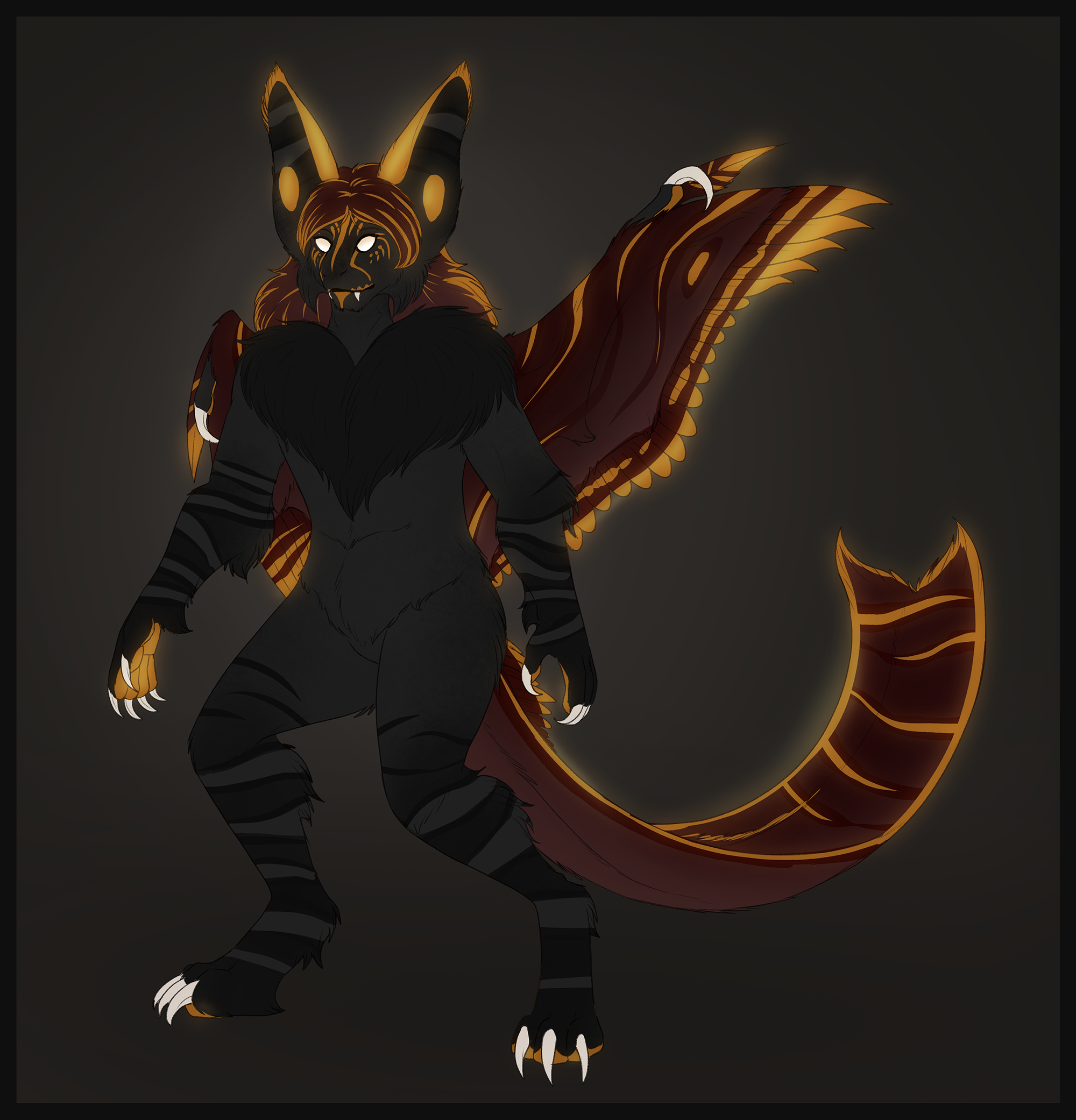
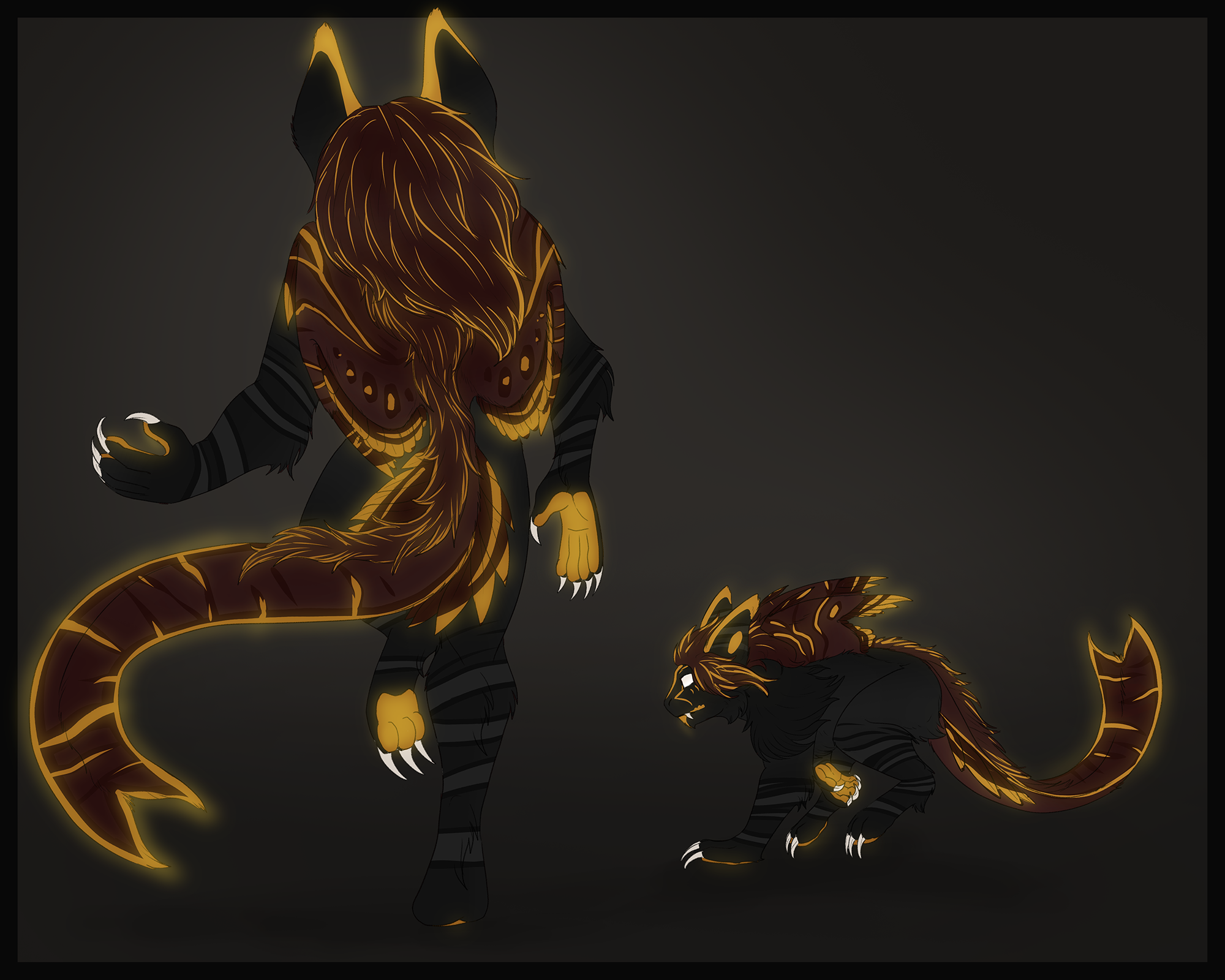
As tall as a Silverwing, but much thicker.
Stoneclaws are known for their large, curved climbing claws, and having claws on their wings alongside the wing feather.
Stoneclaws rarity is the same as Silverwing. They are elusive and mostly seen underground, while other Li'uhn get anxious and claustrophobic underground. They tend to be mellow and are far less restless. Fairly docile.
Stoneclaws can not fly, at all, but are able to drop onto all fours and gallop like that. They can leap and climb incredibly well.
Unlike the chiming call of other Li'uhn, Stoneclaws deep, resonant bell-like tones can almost be mistaken for the call of the il'hune, carrying through the underground.
-Their wings can be almost grey, orangish, or earth tones with tints of the other colors on the wings.
-Trimming can be orange
-Trimming glows
-Eye can have a yell or orange gradient, but not as bright as a corrupted Li'uhn
-Their wings MUST be small. Strongclaws can't fly
-They MUST be bulky, as this is a main feature for them
-Have the special Bat frill by default
-Have a black ruff by default, usually darker than the rest of the Li'uhn, matching the body
-Strata Marking is common among them, creating banding of a few different shades on the limbs and frill
-Can have markings the color of their trimming on their ears, often forming a spot and various markings around the face to serve as a way to identify individuals
-Fluffy!
Seaborn (Li'uhn Subtype)
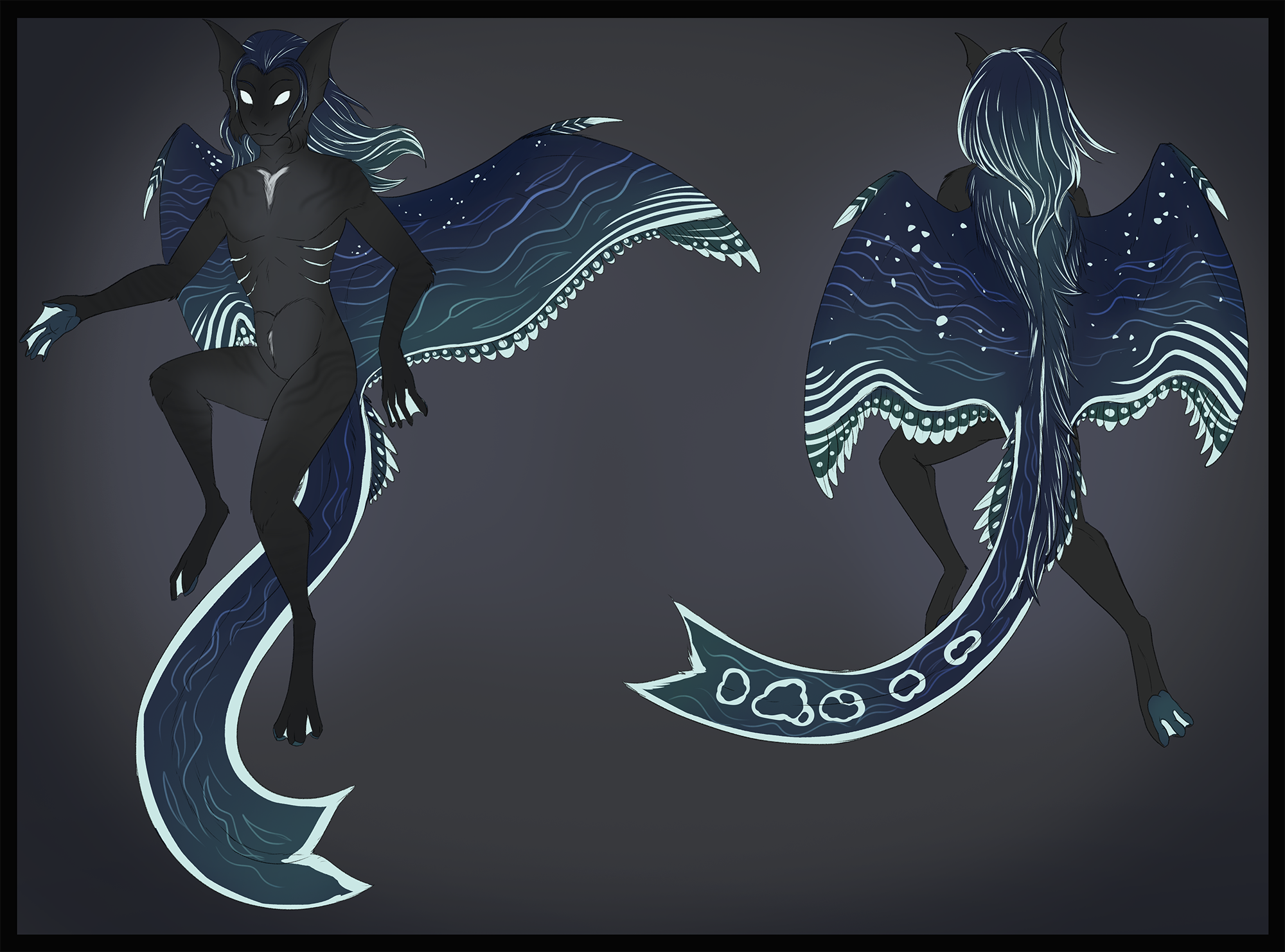
The Seaborn is around the size of a common Li'uhn. They are sleek, with smooth fur and silken hair. Their frills are finlike, and they have sleek wings with short feathers.
Seaborn are fully able to fly in air, but do very well in the water. They have gills on their sides around the ribs that close up when they are out of the water.
Seaborn appear in deep blues and bluegreens.
Their trimming and webbing all glows at will.
They resemble Nightkin in some of their colors, but they can not hide their glow and markings like Nightkin and Shadowcloaks can
They are capable of living in the desert, but tend to stay close to oases or coastal areas. They swim swiftly.
Nightkin (Li'uhn Subtype)
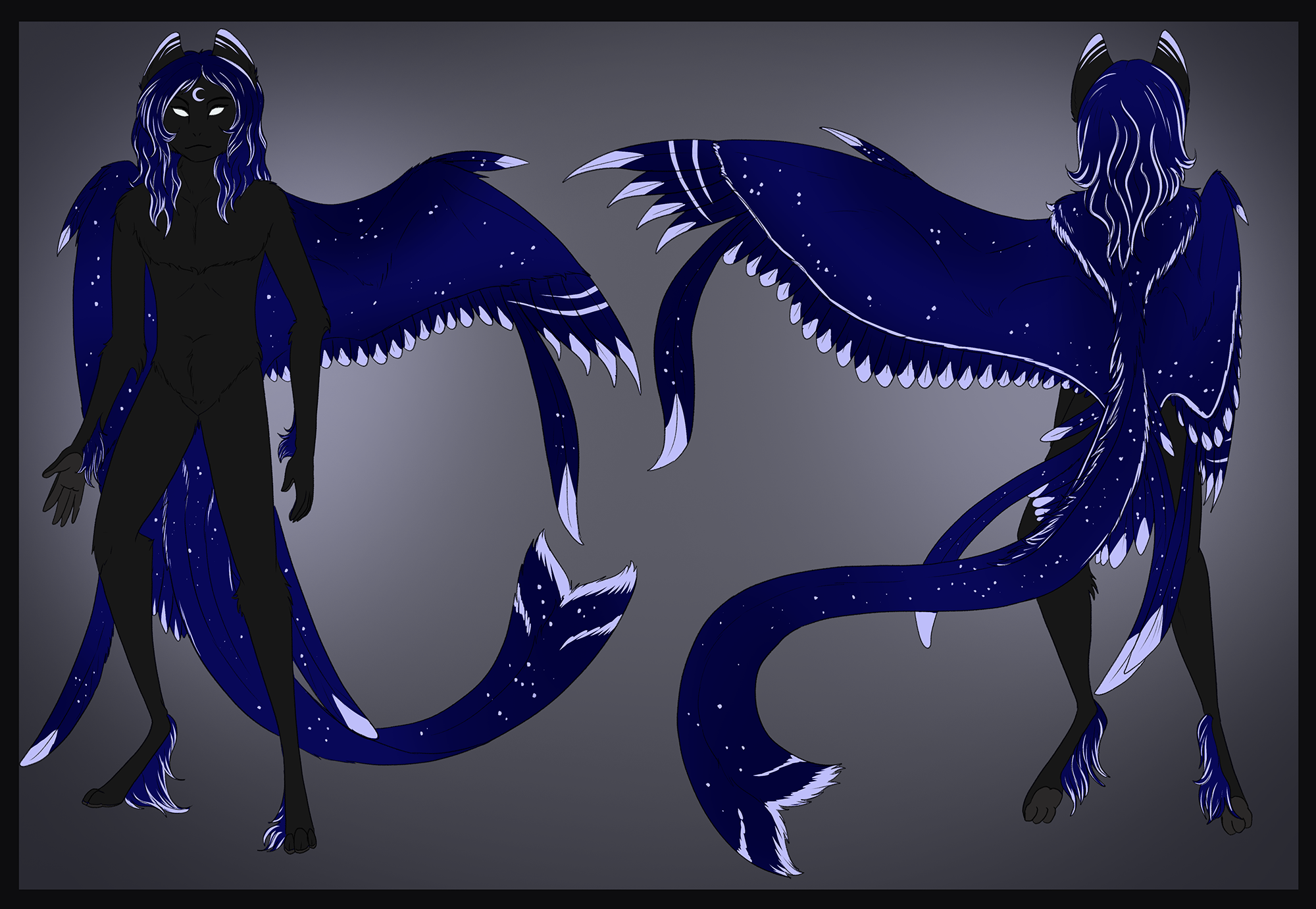 The
The
The second smallest Li'uhn, the Nightkin was created as a spy of sorts. They are small, quick, and love anything shiny. They are known for their dark skin, near pitch black, and their wings being in beautiful deep blue colors. Instead of golds, they have lighter blue markings that can be almost white, which often form dots that mimic stars, and always have a crescent moon or star shaped mark on their forehead. Nightkin are often seen with Shadowcloaks, and crosses between the two types aren’t uncommon. They average at three and a half to four feet tall.
Nightkin have Feathering and Tendrils by default, and can get some markings on their frill. Their hair tends to be flowy and wavy.
Shadowcloak (Li'uhn Subtype)
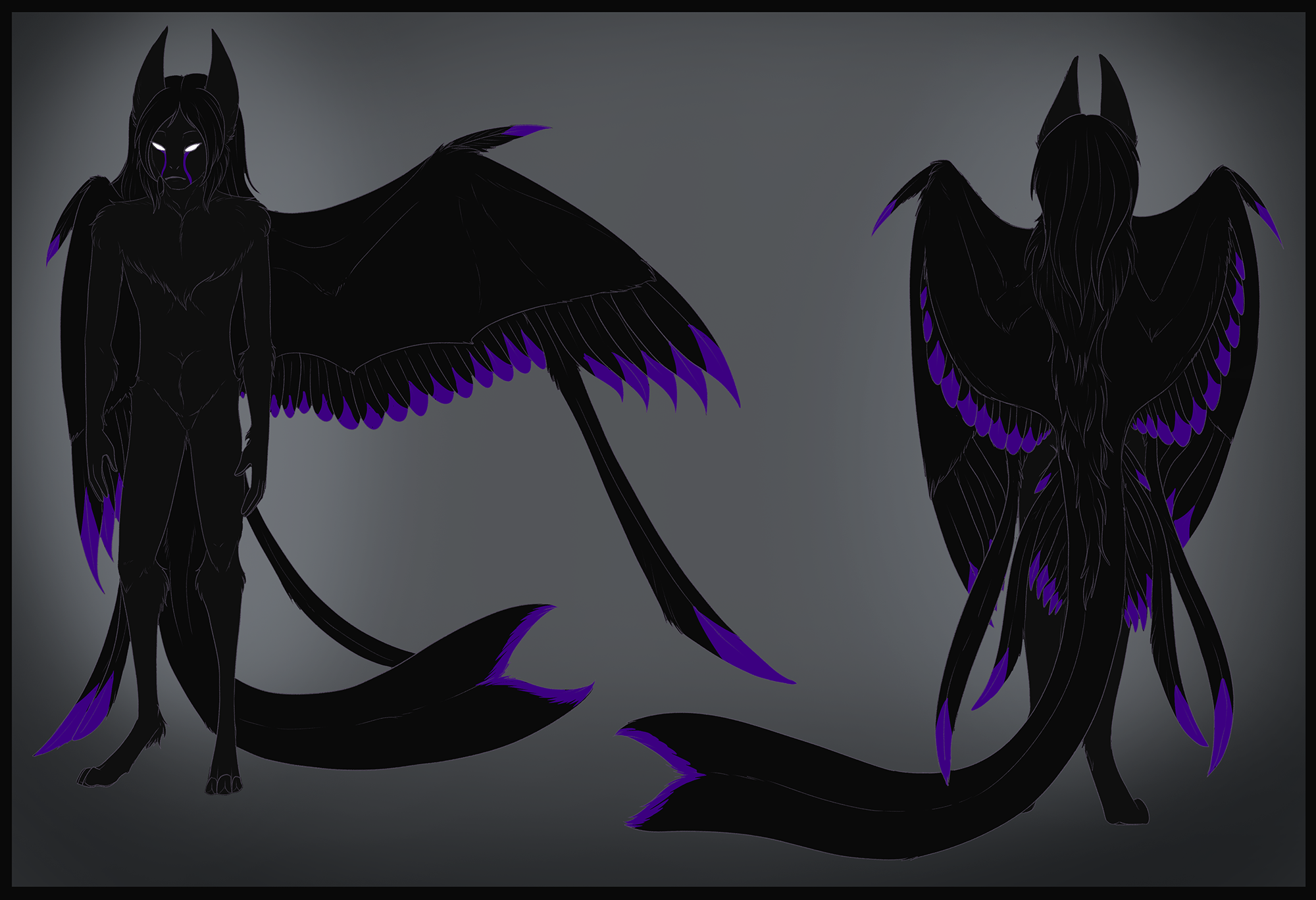
Able to hide themselves entirely in the shadows, these Li'uhn are tall, but timid. They are known to be incredibly elusive. They are entirely black with deep blue or indigo markings. They can obscure themselves and anybody they touch entirely in shadow, so thoroughly that even energy sensing creatures, including other Li'uhn, can’t sense them or the one they are hiding at all. Usually around six feet tall.
Their fur and hair is naturally silky and smooth. They come with the Tendril mutation by default, and are known for the unique tear markings on their face. They come with the Anubian frill by default.
Their hair and manes tend to be flowing.
Il'hune (Li'uhn Subtype)
The creator of the Li'uhn, there are only six individuals that exist. They will never be made available, as the six left can't reproduce and are only around as a sort of punishment for what their kind did in the past.
See more information on the Il'hune here
Normal (Kivuuli Subtype)
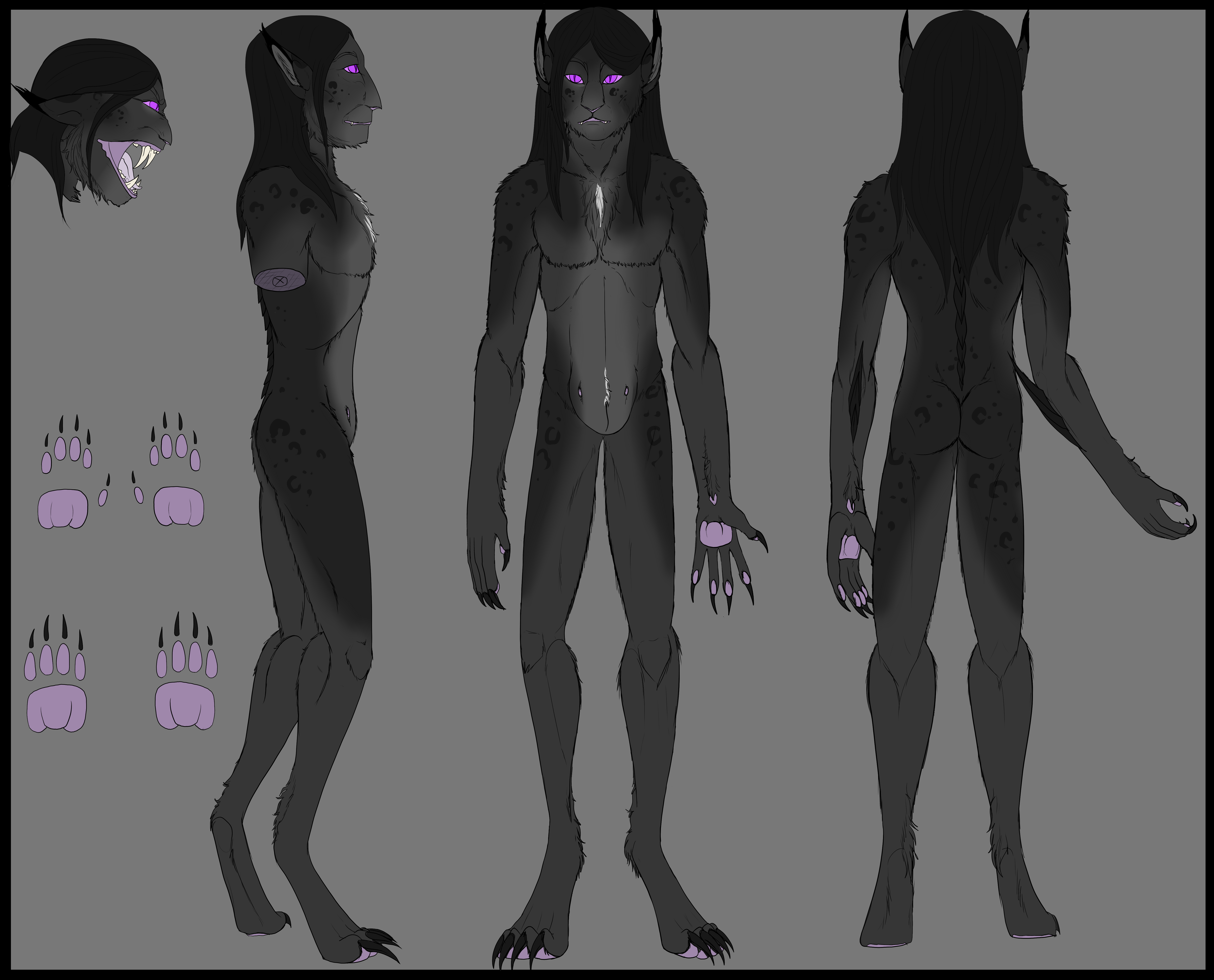
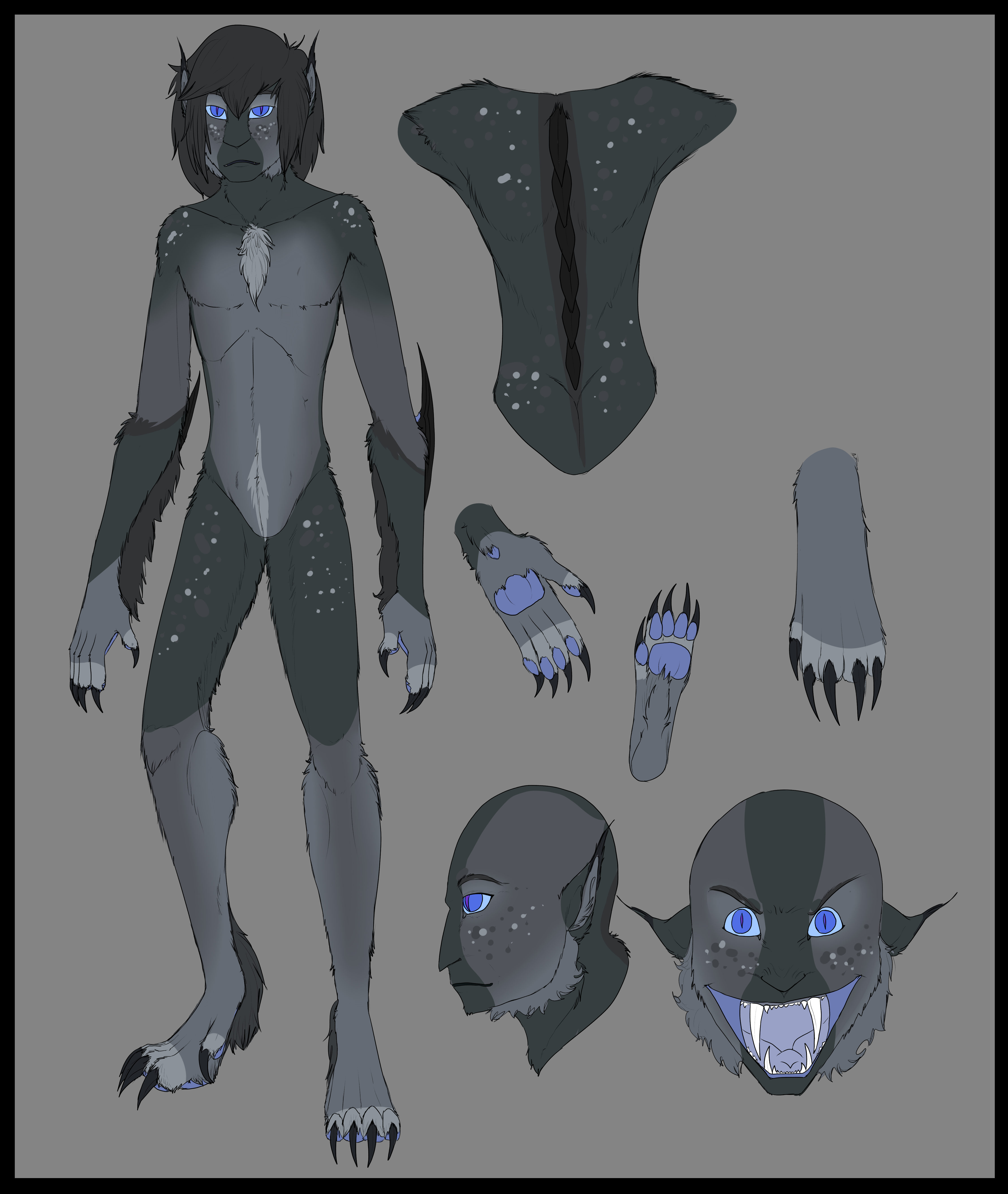
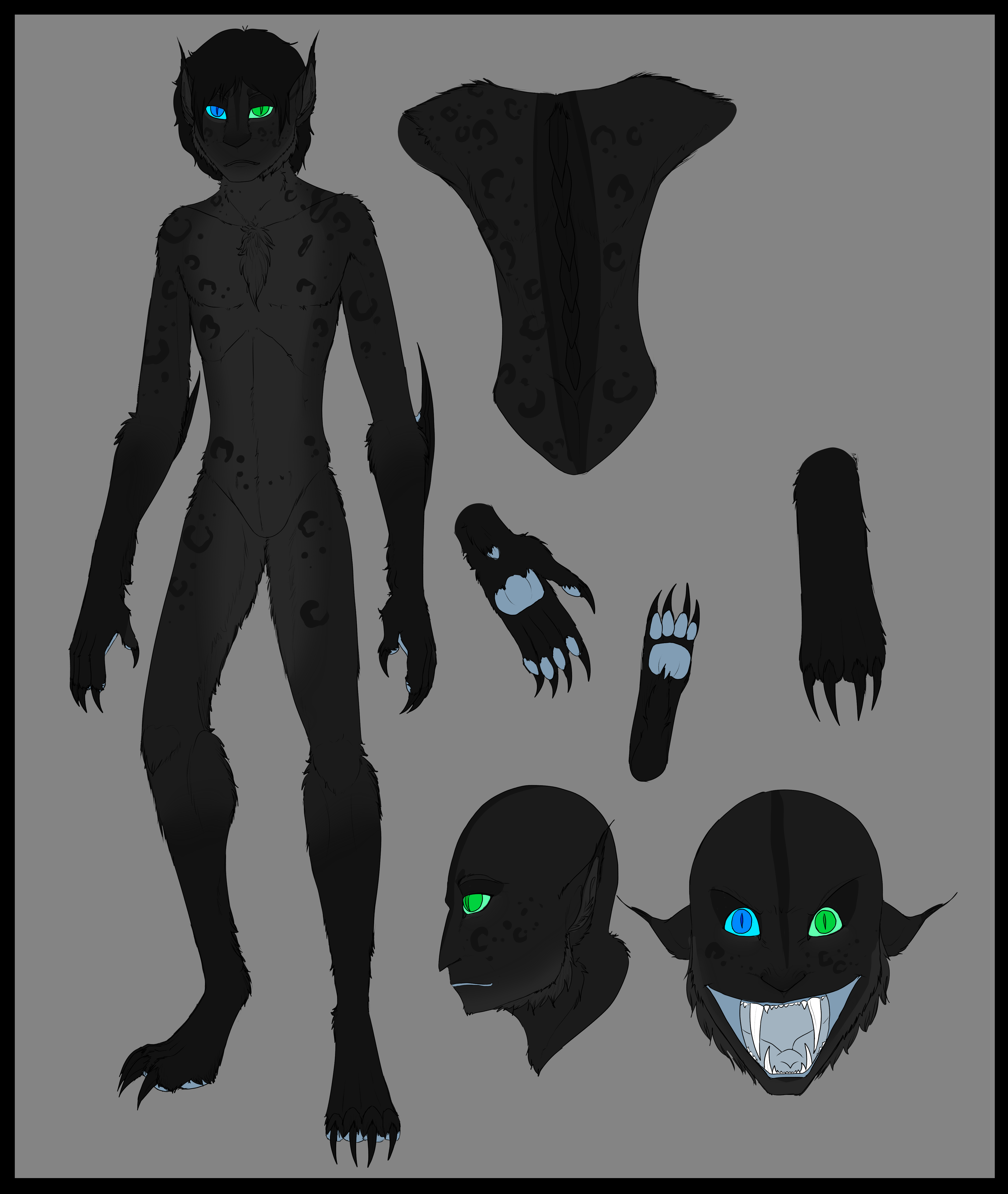
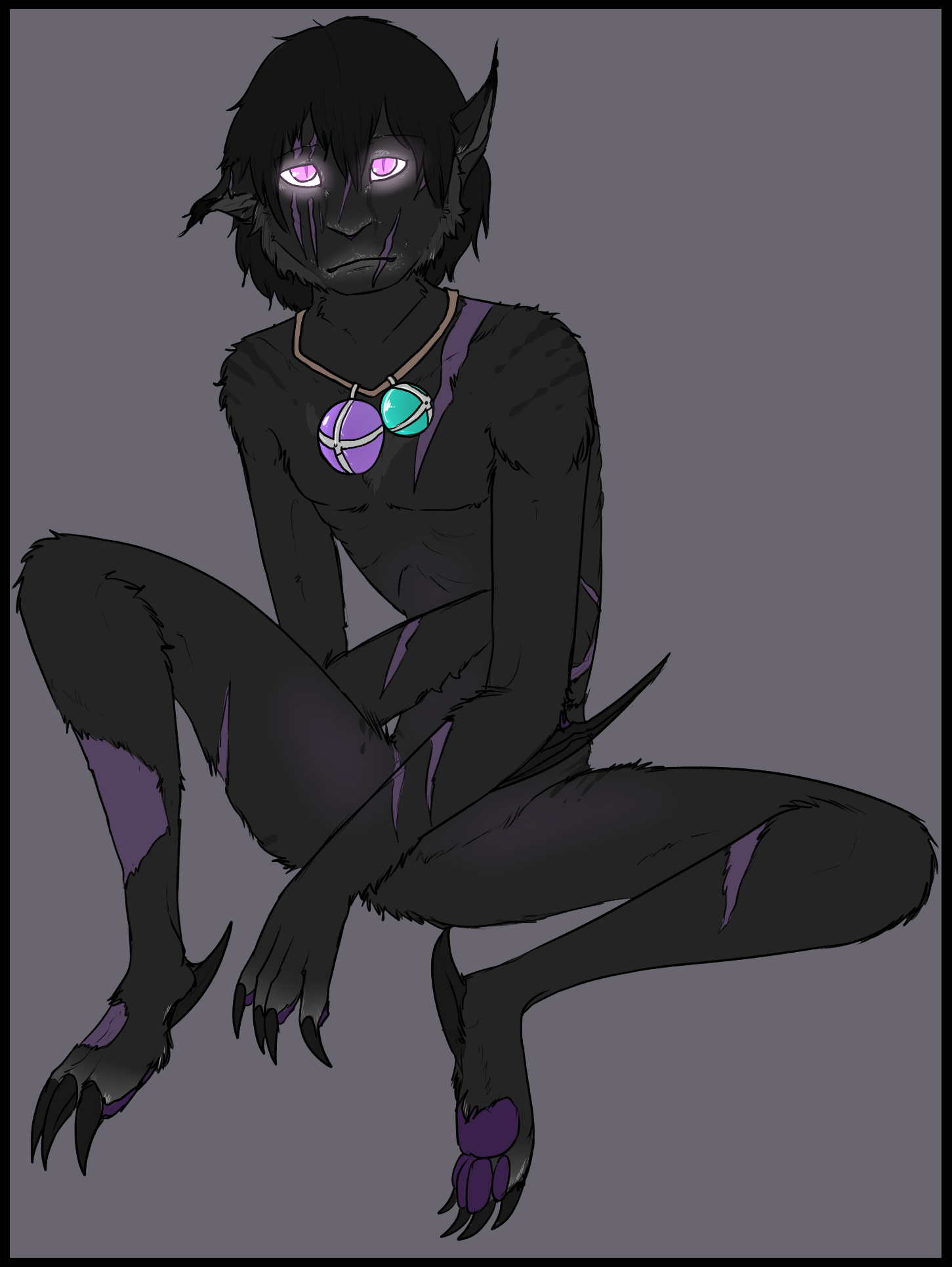
The basic Kivuuli. The Normal Kivuuli is the most common example of the species.
Most of their information is found under Basic Information and Anatomy and Physiology, since they are the original Kivuuli, and the most common type.
Normal Kivuuli are always black or charcoal gray in coloration with purple, blue, green, and golden yellow orange eyes being the most common. The second example is on the lighter side of the spectrum of their coloration.
They are usually darkest on the back, shoulders, and hips and lightest on the belly. Their hair is always darker than their base coat, or black. It is never two toned, and won't have differently colored tips unless the Kivuuli purposeful does this. Elders, though, can have graying hair, or streaks of white. Their hair can take on any texture human hair does, though is usually soft and slightly fluffy. Straight and wavy are the most common. They can have striping or spotting, or a combination. They can sometimes have a small white or lighter patch of fur on the chest, belly, or crotch area and sometimes on their face or finger and toe tips. Their markings are usually slightly darker than their base color, but can be slightly lighter as well. Their markings always look natural, and often resemble various felines.
Normal Kivuuli are found just about everywhere. They are incredibly common in Between and outside of it as well. All the other breeds descended from the normal Kivuuli, and their numbers are incredibly high with the sheer size of their home-realm.
Dykuma (Kivuuli Subtype)
Another Kivuuli subspecies is the Dykuma (Called Kuma for short) Kivuuli. They evolved in the savannas and deserts, outside of Between. They are slim and incredibly nervous and jumpy. They hunt at night, and are specialized to hunt the various fauna found in the desert and savannah lands. The majority of their diet consists of jackrabbits, lizards, snakes, insects and rodents. They are immune to snake venom, and if they eat enough venomous snakes, they will actually store the venom in their saliva and use it against larger prey they may find.
These Kivuuli are not as tall as most, averaging around seven feet tall and spend most of their time asleep in their dens, usually clawed into sandstone and covered in grass.
They are most active at night, dawn, and dusk and generally avoid the heat of the day.
They have membranes that reach high on their spines, which they use to control their body temperature. It helps them shed heat like the jackrabbit’s large ears, and gather heat on cold mornings.
Their fur is very thin and short, but can puff up to keep them warm on cold mornings. Desert winters can be harsh and cold, and thus they grow in a thicker coat during the winter and shed it in the spring. When not hunting, they are sleeping, and come off as downright lazy.
Skittish and flighty, this subspecies will not attack you. If attacked they will quickly run away be it night or day.
Their dewclaws spread out to the side, and they have webbing on their pawlike feet, this allows their weight to spread evenly when walking on sand. Their pads are incredibly thick and heat resistant.
Colonies are small, usually consisting of small family units, and any loners that may join with them. A female often seeks out other Kivuuli territories when in heat, for greater genetic diversity since members of a Colony are often related. Like all Kivuuli, the females are bigger, stronger, and more dominant than the males; but their spines are the same length for both genders since they are used for heat management and not just for dominance or show. Like all Kivuuli, males are more common than females.
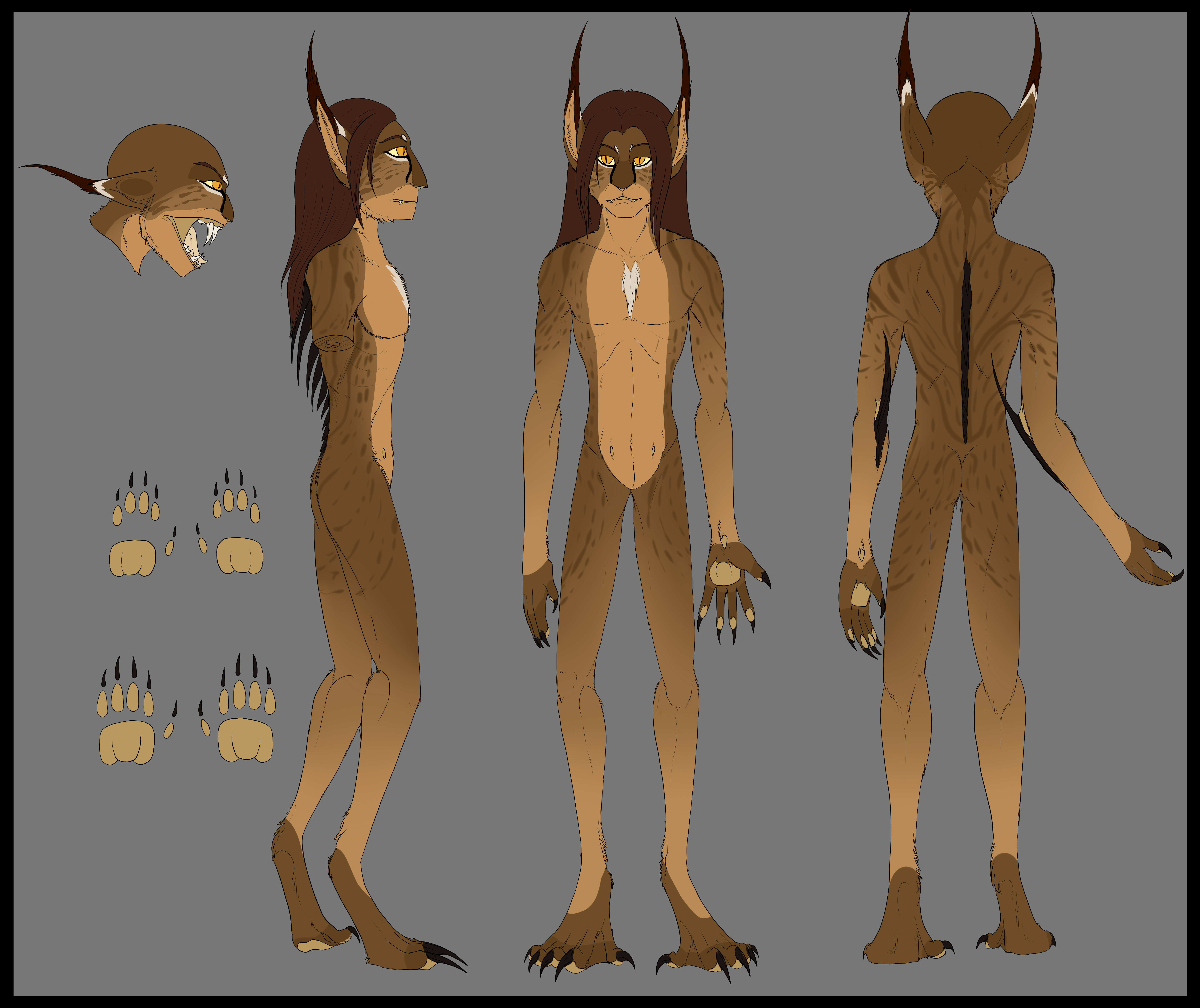
Malopuh'rra (Kivuuli Subtype)
Malopuh'rra are the smallest Kivuuli subspecies, and the only subspecies that has a venomous bite. They produce the venom from the toxins in the various small creatures they eat. While not deadly, their bite is extremely painful. It causes cramping, stomach upset, headaches, rushing heartbeat and heavy breath and will immobilize a potential threat for a few hours.
They are not aggressive, however, and only bite in self defense. They are quick, energetic and friendly. There are two variants. The slightly larger, more timid desert dwelling Puh'rra, and the urban Puh'rra, a bit smaller and darker in color. Some even resemble domestic cats in their coloration.
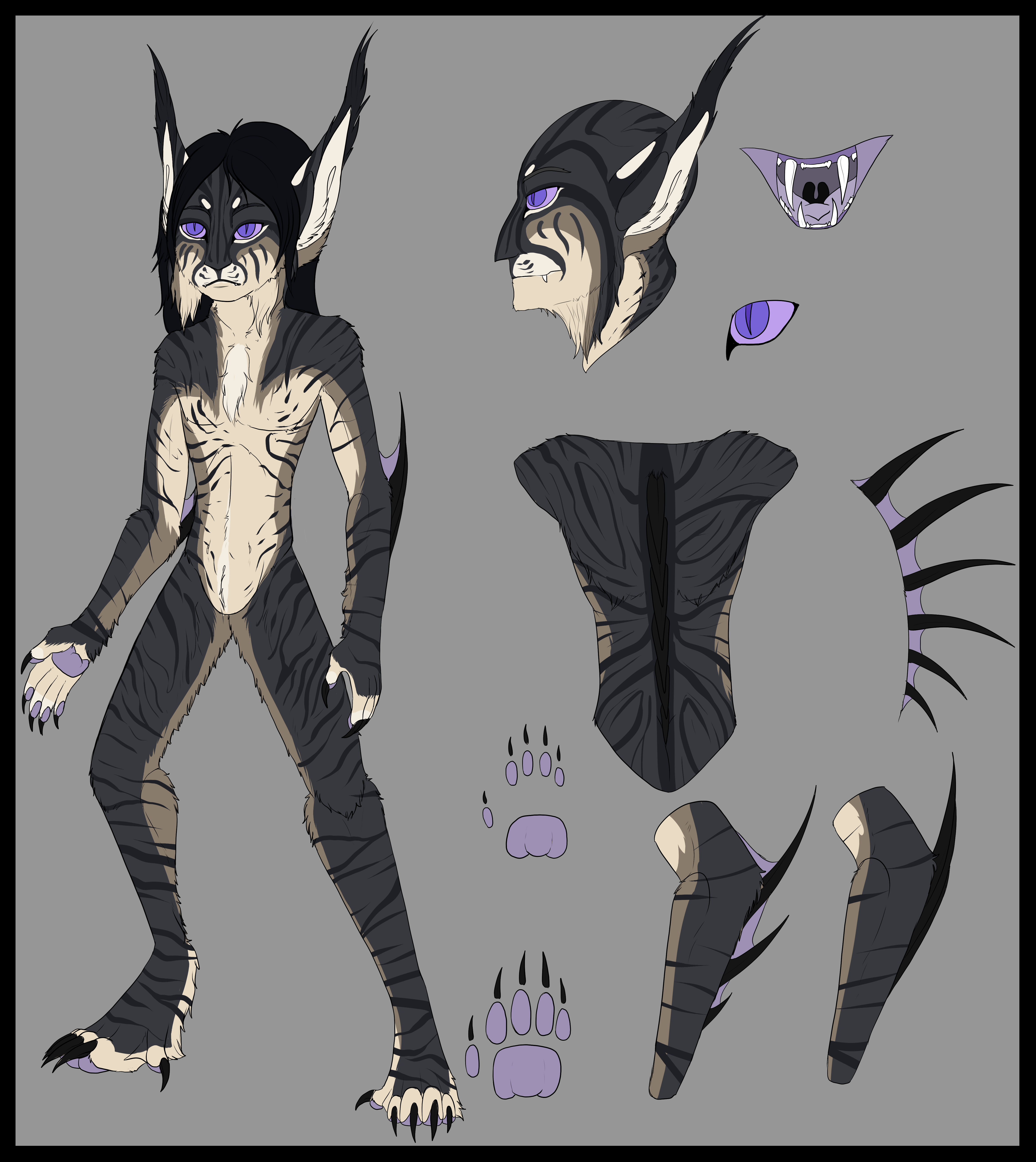
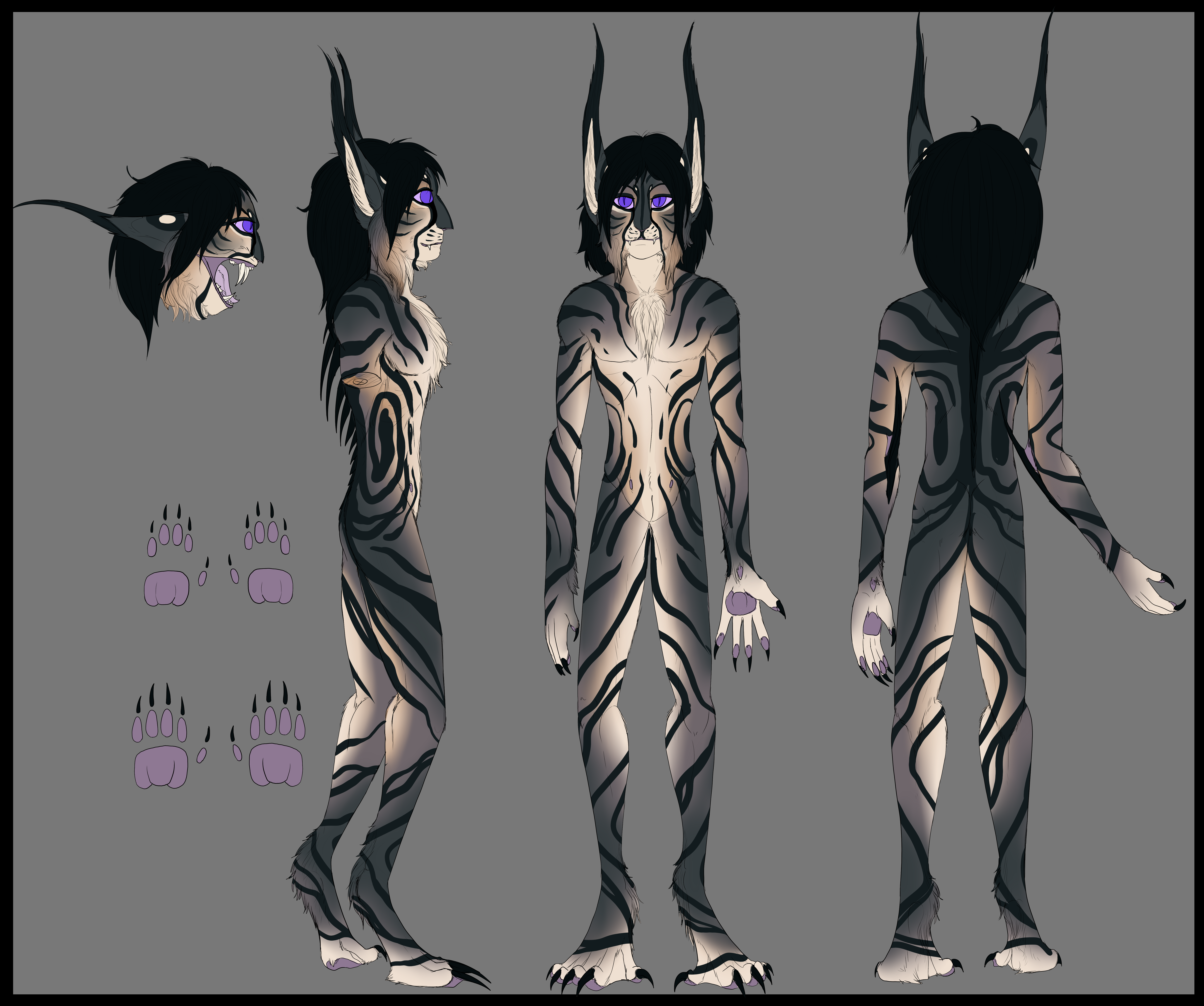
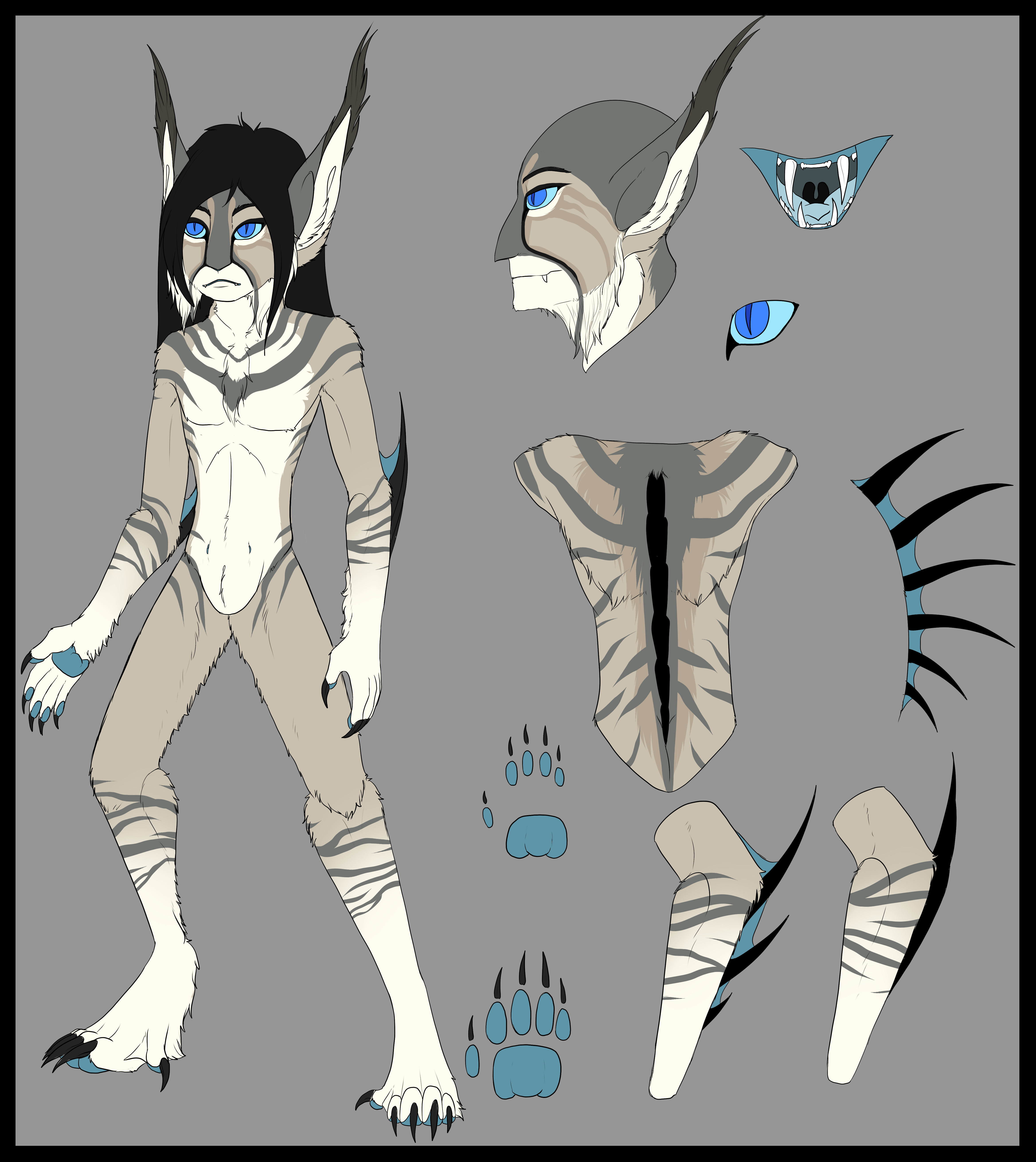
Tundra (Kivuuli Subtype)
The Tundra or Snow Kivuuli is a Kivuuli that evolved and adapted to extreme cold, snow and ice. Some parts of Between are extremely cold and full of ice and snow. Being between dimensions, all sorts of places have different environments connected to the dimension or world that is the closest to a certain area of Between.
Like Maltese, they came from a fairly small gene pool and evolved in isolation. This is because the Colony they originated from were small as compared to most Kivuuli. They were driven out of prime lands by bigger, stronger and fiercer Kivuuli. Tundra Kivuuli are usually in muted soft browns and grays like the arctic fox. Like standard Kivuuli, they often have spotting and striping. It can appear lighter or darker than their base coat. Because of their speed and strength, they do not need white fur to blend in to hunt, though they are known to bury themselves in snow drifts and lie in wait to ambush their prey.
This gradually forced them to the most inhospitable areas of Between. They found there was less competition for territory and food in the cold icy isles, and fewer Kivuuli fought over dimensional rifts leading to worlds full of snow and ice. Those of lighter color and thicker fur survived, whereas those that were darker in color stood out too much to hunt, and those with thinner fur froze to death. Through natural selection, they eventually lightened in color until they took in a more yellowish white tone and their fur grew into thick, three layered insulating fur. The underfluff, extremely thick and warm, the longer outer fur, and a bristly layer over that to help slough off ice and snow. From there, they thrived, and quickly grew in number, quickly filling the polar and arctic niche in not only Between, but many worlds connected to Between.
Those with spurs pointing downward had fewer slips and falls, and thus this feature remained.
These Kivuuli don’t teleport often, preferring to run on all fours and are even more feral and wild than Maltese, nearly atavistic and are considered closer to their Protean ancestors aside from size. Unlike Maltese, they are not friendly. They are highly territorial and tend to gather in small pack-like colonies of ten to twenty individuals. Usually lead by a female with several males to do the hunting and bring her food. She will mate, have the omegas care for the kit, and mate again. Other females are permitted to remain within the Colon, but if they challenge the alpha female, the fight always ends in the loser being chased out of the territory. Females generally leave their own colony during heat to seek out a strong male from another colony, since many colonies are made up of related individuals.
Unlike most Kivuuli, it is not uncommon for males to live and hunt alone and nomadic. The Arctic Kivuuli, in fact, is one of the only Kivuuli that doesn't go completely mad when alone, though they do still end up hunting with packs of arctic wolves, or even bears to ease their solitude when alone. Lone males generally wander in search of a viable female to mate with. These lone males are likely responsible for the subspecies to still be alive, since they allow for more genetic diversity. Tundra Kivuuli do much better alone than their more social cousins.
Other Kivuuli do not venture into their lands, since the harsh cold is hard to hunt in and pierces right through their thin fur coats.
These Kivuuli, while once smaller, are now around the same size as regular Kivuuli and have a thick layer of fat beneath their skin to keep warm.
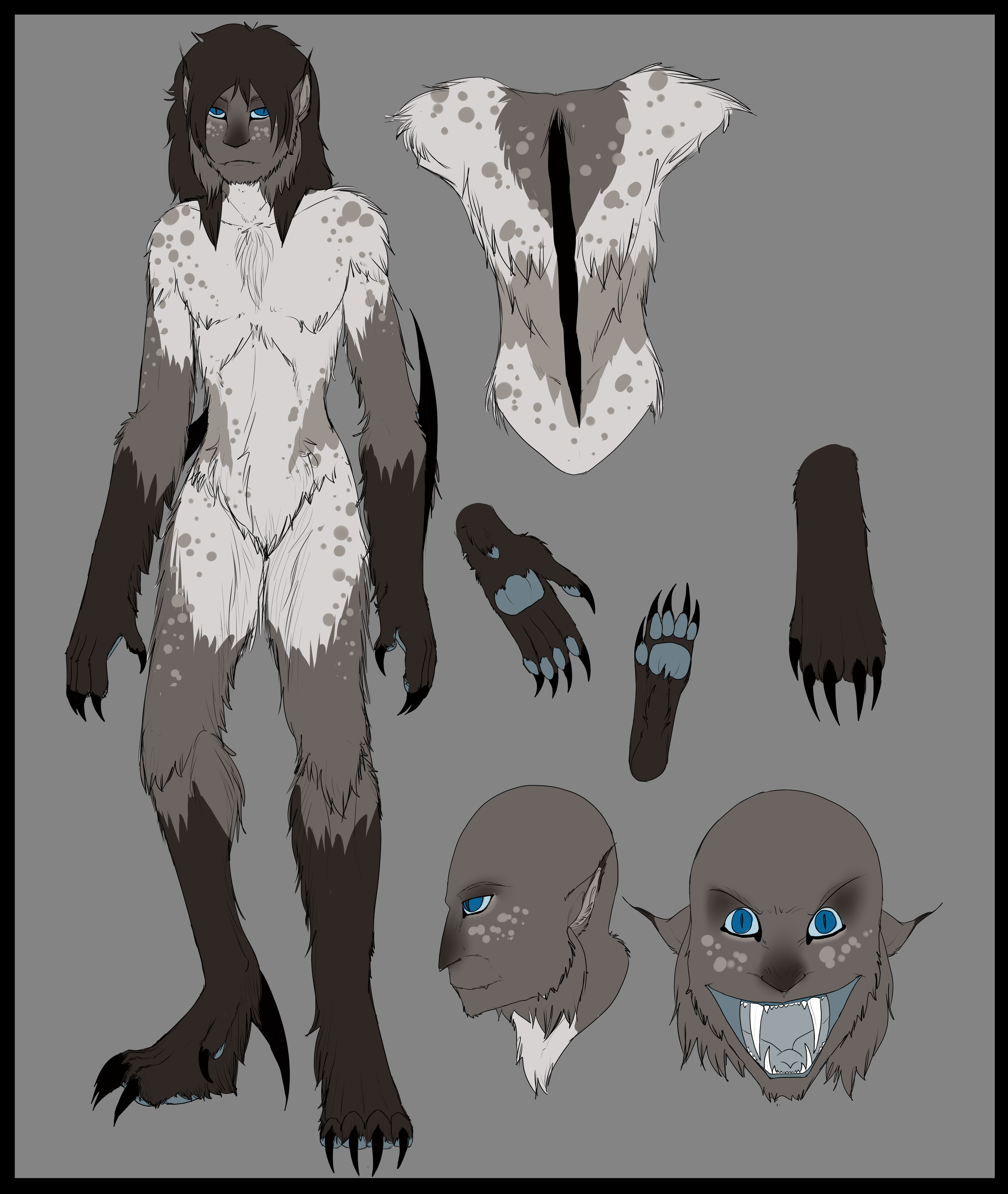
Winter Coat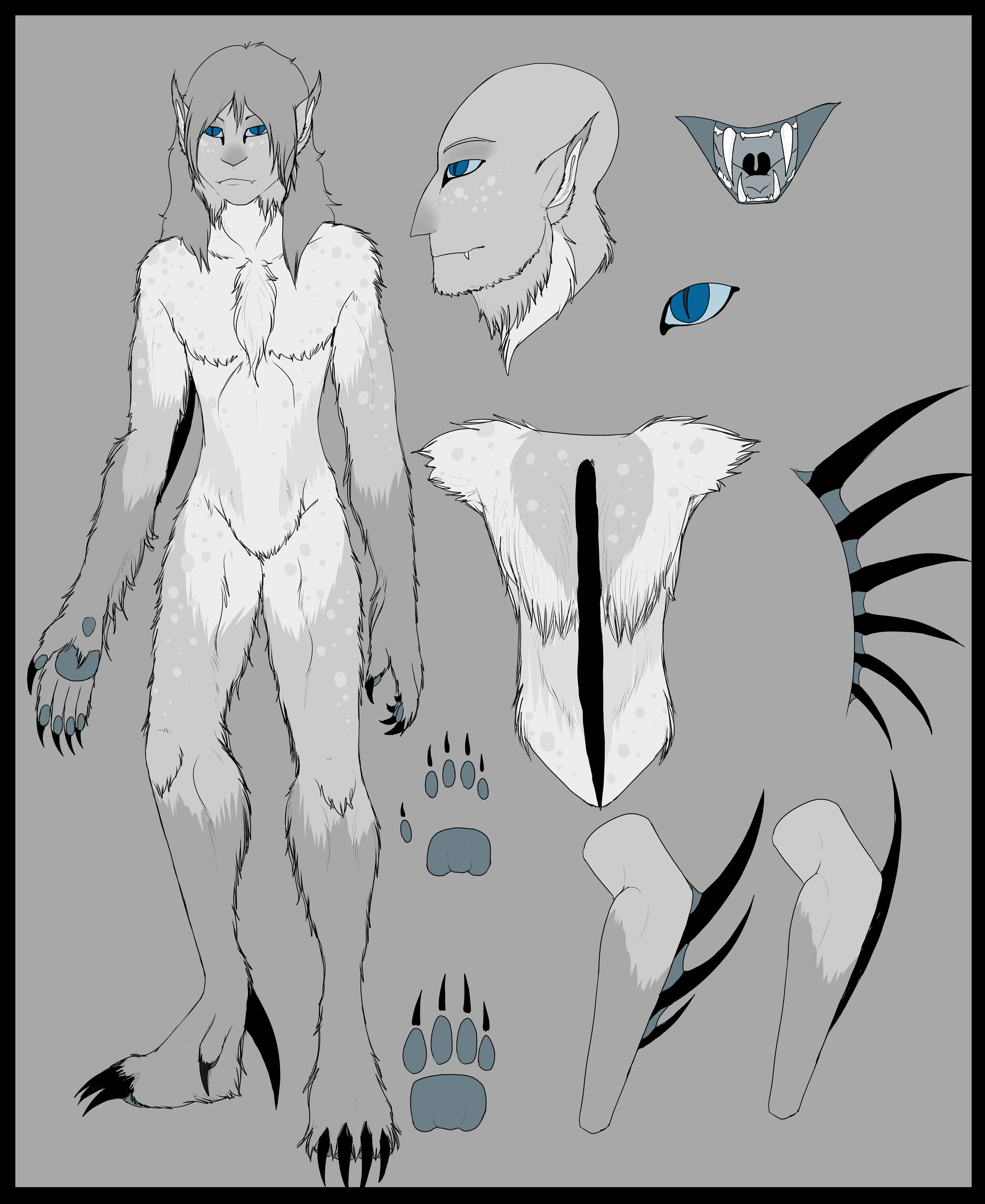
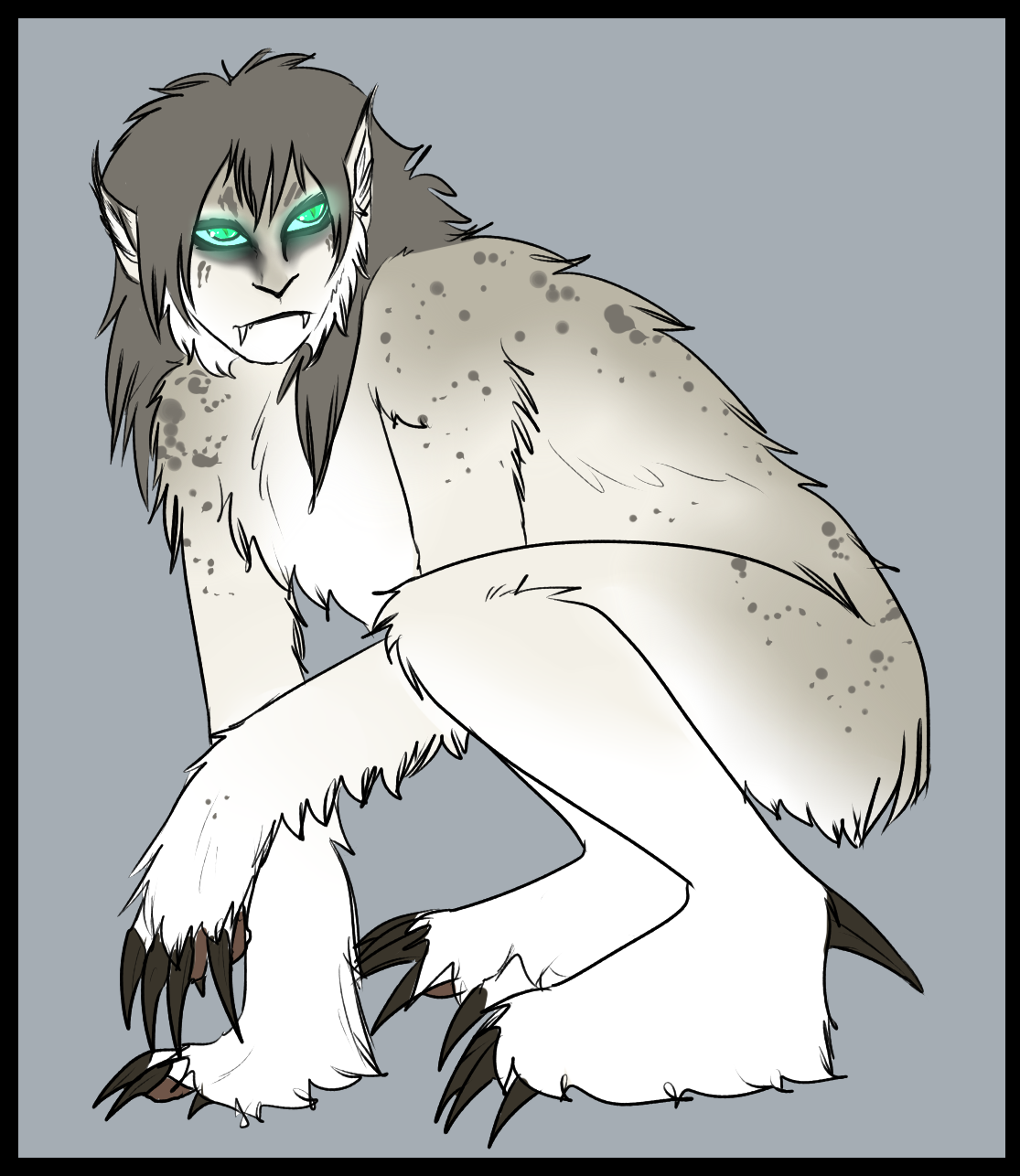
Maltese (Kivuuli Subtype)
The Maltese Kivuuli are a population of oddly colored Kivuuli that have been isolated for hundreds, possibly even thousands of generations. Because of the small, isolated population, a lot of extremely rare genes have become present and dominant and a collection of strange and new mutations have shown up.
As such they have become their own distinct subspecies of Kivuuli, much different than those more commonly seen.
Maltese have a color mutation that dilutes the usual black down to a blue/gray coloration. The fur is generally darker close to the skin and often has frosted tips. They always have a black sclera. Lavander accents are known to show up every so often and can appear in varying degrees. Their base coat can vary from a dark blue-gray, to a pale almost white blue-gray. Their stomachs and inner thighs are usually lighter than the rest of them, and they are usually darkest on the back. Dorsal stripes are very common.
They almost always have black markings somewhere on their bodies, with stripes and spots being the most common, like normal Kivuuli. Some have no markings, or the markings are very faint. This is fairly rare. Most Maltese have white hair.
They all have exotic eye markings which usually appear in black unless affected by a coat modifier or mutation, black scleras, and unusually bright eyes. Blues and Purples are most common. Greens, Yellows, Reds, Oranges, and Golds can show up as well but are not as common
Their fur is like chinchilla’s fur in texture; extremely thick and dense and extremely soft and fluffy. They are softer and their coats longer and thicker than normal Kivuuli. In short, Maltese have a LOT of fur. If you were to touch one your hand would sink in past the wrist. The skin beneath is very tough and thick and hard to cut through. They have some coarser guard-hairs down their upper backs and shoulders where their fur grows in the thickest.
Many have a thicker puff of fluff on their chest which often matches their hair in color. This can appear with or without a mane. A mutation exclusive to Maltese Kivuuli. When frightened, the guard hairs on their backs and shoulders puff up like a dog’s hackles along with their spines. Like regular Kivuuli, Maltese females have longer, sharper, and fiercer looking spines than the males.
The subspecies has only just recently started showing up in our dimension and others; and is extremely rare since there are fewer than a thousand in the main Colony, and mortality rate is fairly high. They are too far from any other island of Darkrealm to get there, even through teleportation; and thus come to other dimensions through naturally forming portals that appear sometimes. Maltese have the ability to teleport further than regular Kivuuli; due to a mutation carried over from the Colony the subspecies rose from.
Maltese, or Blue Kivuuli have many mutations that are exclusive to their subspecies. Their most unique feature is the presence of natural hermaphrodites, something that does not exist among any other Kivuuli subspecies but is theorized to be responsible for them having survived.
Probability of hermaphrodites is VERY high. Around 75% of Maltese Kivuuli are hermaphrodites and 80% of these hermaphrodites are completely functional. Most hermaphrodites take after one gender or the other, but masculine hermaphrodites are more common. Both Masculine and Feminine hermaphrodites are fairly androgynous in appearance. Each generation that passes, the percentage of hermaphrodites increases, since it is due to a mutation that has become a fairly dominant gene in their makeup. A hermaphrodite has a 50% chance of producing a hermaphrodite offspring.
Females, like normal Kivuuli, have longer and sharper spines, especially down their backs.
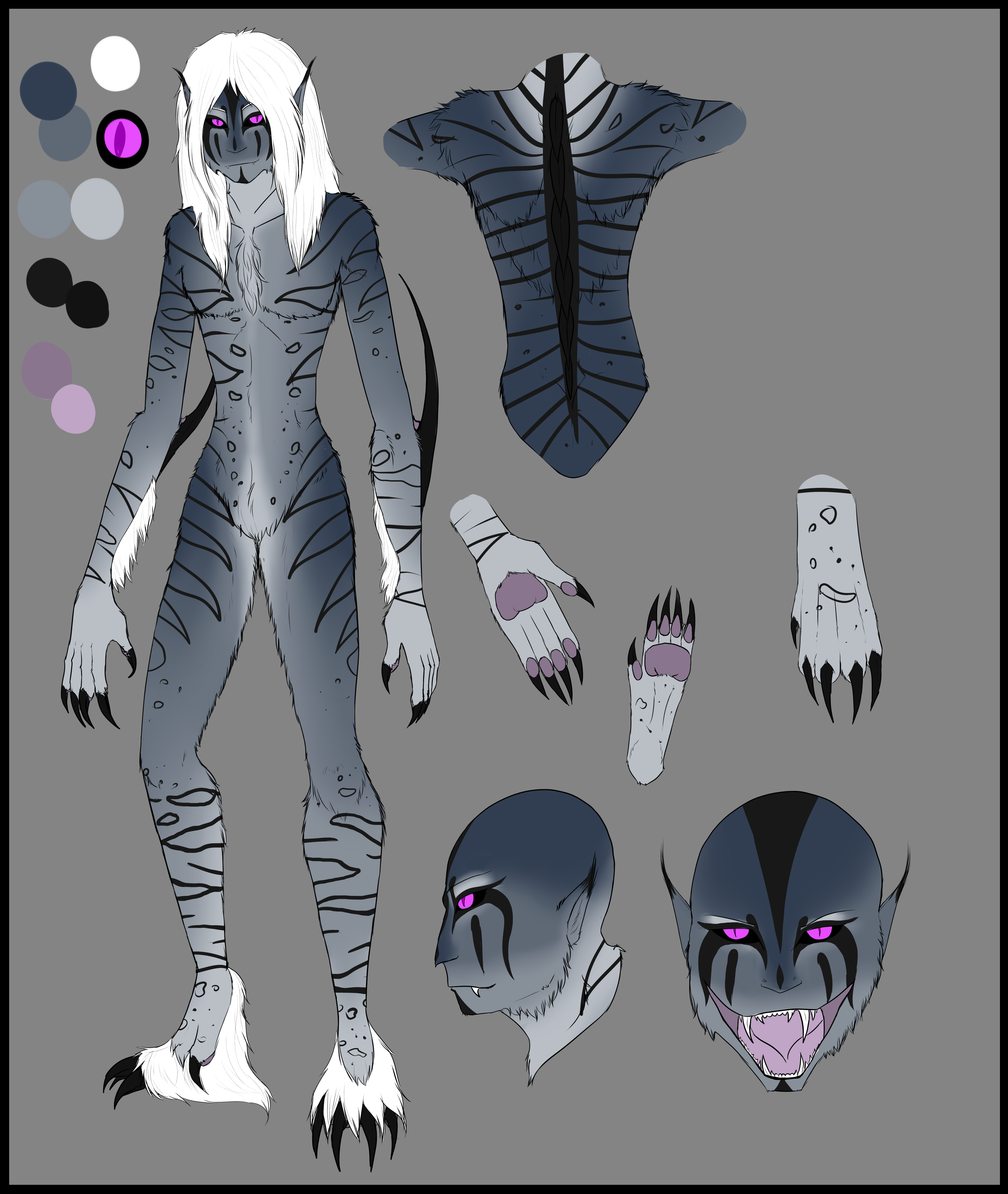
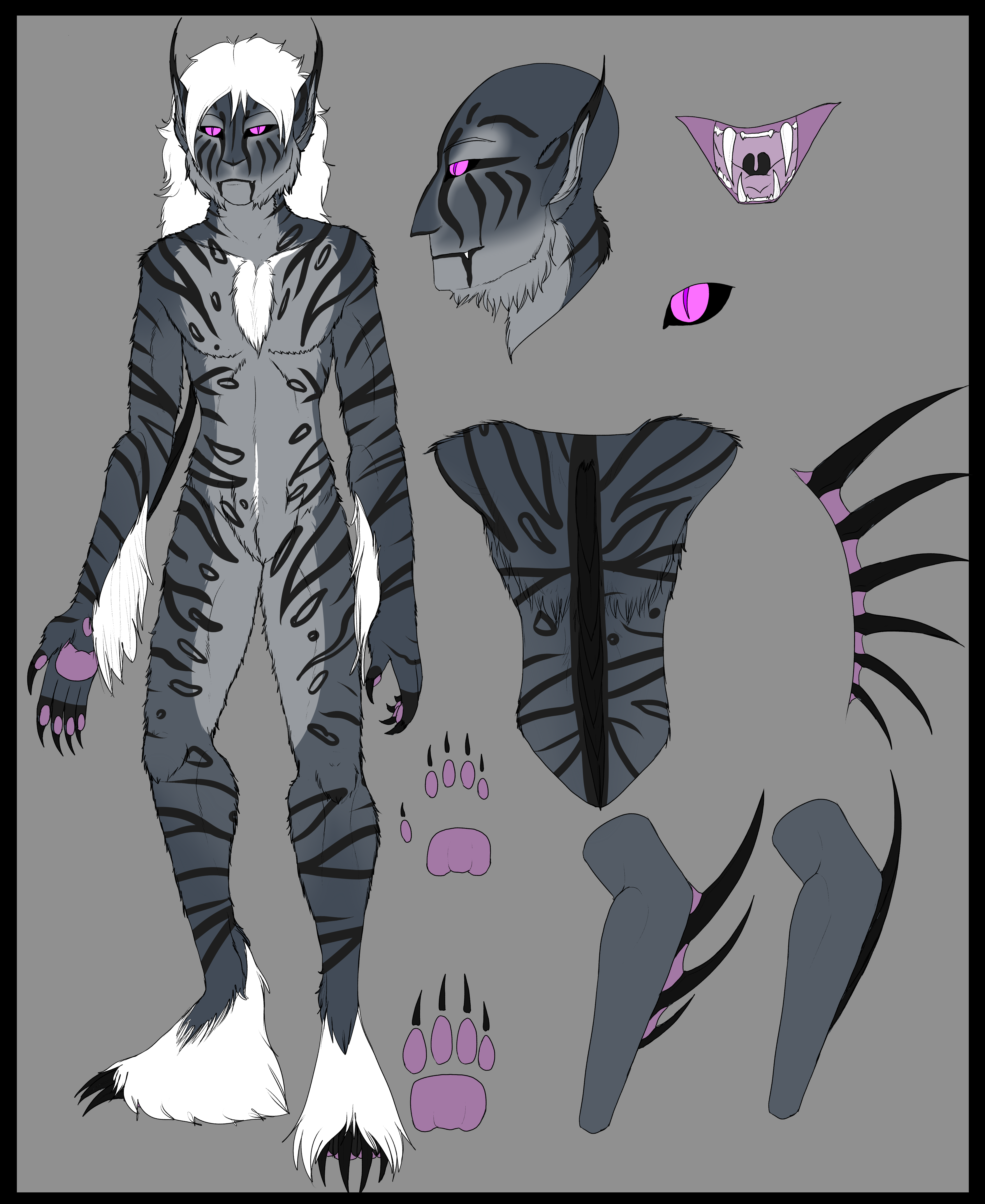
Ember (Kivuuli Subtype)
Ember Kivuuli were only recently recognized as a variant, and only exist in one single known Colony, though some members of this variant that aren't a part of that colony have been observed, leading some to think there are more colonies somewhere in Between. Embers have longer fangs, forming sabers, thin short fur with a coarser texture than normal Kivuuli, and an iridescent sheen. They rarely have many markings, though lighter colored mottling can be found around the shoulders and hips and on the face. Usually in reddish tones, or orangish adding to the Ember illusion. Their eyes are usually fiery in color. Their origins are unknown, but some suspect that those with these features were considered attractive until the breed was established.
The first Desert Kivuuli descended from the same line as Ember Kivuuli and can sometimes show the reddish sheen.
Embers are slightly smaller than normal Kivuuli and slimmer. Their temperment is roughly the same.
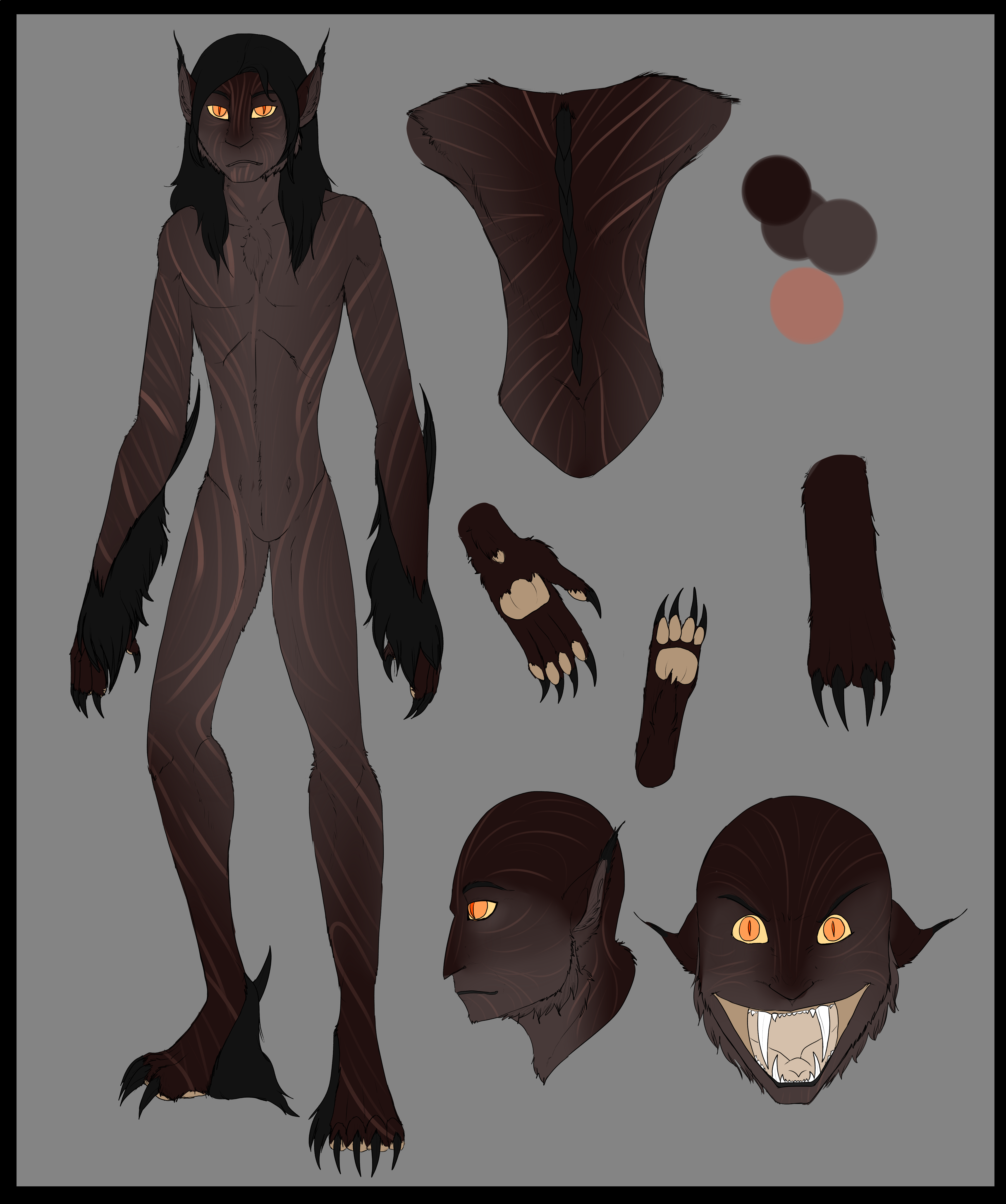
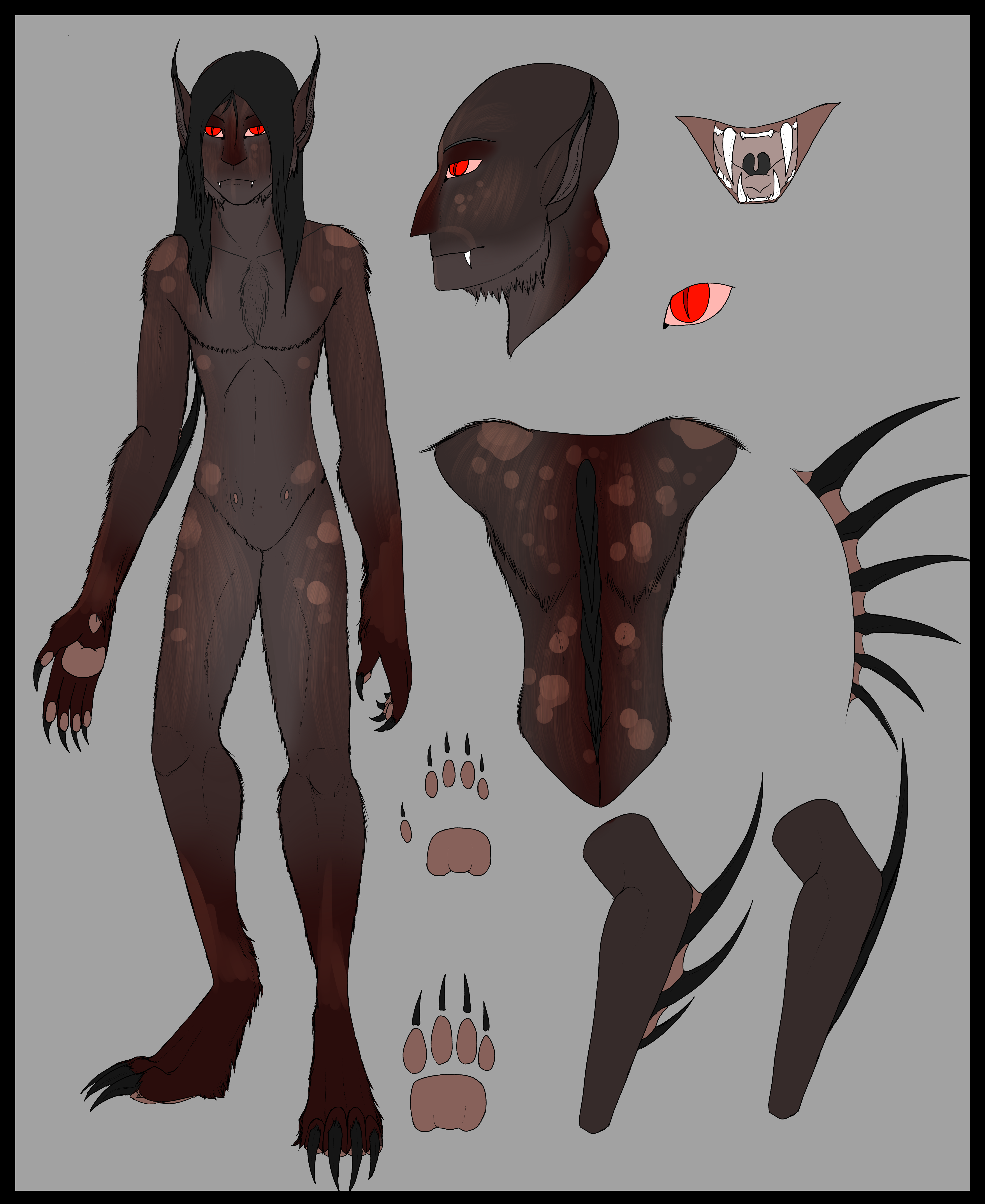
Kaplan (Kivuuli Subtype)
The Kaplan Kivuuli is a result of the Met'saa and the Desert Kivuuli interbreeding, and several generations in it created a new breed, a golden Kivuuli similar to a tiger in appearance. Most look like a strawberry tiger, and can range from reds to oranges, to orangish golds. Most Kaplan have extended fanged canines, sticking down over their lower lip.
Their ears are large and the tufts slightly curled and they can be found in savannahs, scrublands, brushlands, and temperate or warm forests.
Their markings are usually tiger like stripes, usually a darker variant of the base coat, but can be black. The hair is usually darker, than the base coat or black.
Blue eyes are the most common, though yellow and green eyes are common as well.
Kaplan Kivuuli, like their Desert Kivuuli ancestors, live in small colonies consisting of the alpha female, her mate, and their offspring. They are the only breed known to be strictly monogamous. The young stay with their parents until they find a mate of their own and start their own Colony. Colonies are peaceful towards eachother, and can be considered sub-colonies, though not as structured as the Met'saa.

